 | –≠–ª–µ–∫—Ç—Ä–æ–Ω–Ω—ã–π –∫–æ–º–ø–æ–Ω–µ–Ω—Ç: LU3X54FT | –°–∫–∞—á–∞—Ç—å:  PDF PDF  ZIP ZIP |
Document Outline
- Introduction
- Features
- Description
- Pin Information
- MII Station Management
- Absolute Maximum Ratings (TA = 25 ∞C)
- Electrical Characteristics
- Package and Thermal Characteristics
- Outline Diagram
- List of Figures
- Figure 1 . LU3X54FT Device Overview
- Figure 2 . LU3X54FT Single-Channel Detail Functions
- Figure 3 . Typical Single-Channel Twisted-Pair (TP) Interface
- Figure 4 . Typical Single-Channel Fiber-Optic Interface
- Figure 5 . Smart 10/100 Mbits/s Bused MII Mode
- Figure 6 . Separate 10/100 Mbits/s Bused MII Mode
- Figure 7 . LU3X54FT Pinout for Normal MII Mode
- Figure 8 . LU3X54FT Pinout for Bused MII Mode
- Figure 9 . Thermal Characteristics
- Figure 10 . MDIO Input Timing
- Figure 11 . MDIO Output Timing
- Figure 12 . MDIO During TA (Turnaround) of a Read Transaction
- Figure 13 . MII Timing Requirements for LU3X54FT
- Figure 14 . Serial 10 Mbits/s Timing for TPIN, CRS, and RX_CLK
- Figure 15 . Serial 10 Mbits/s Timing for TX_EN, TPOUT, CRS, and RX_CLK
- Figure 16 . Serial 10 Mbits/s Timing for TX_EN, TPIN, and COL
- Figure 17 . Serial 10 Mbits/s Timing for RX_CLK, CRS, RXD, TX_CLK, TX_EN, and TXD
- Figure 18 . Serial 10 Mbits/s Timing Diagram for RX_CLK and TX_CLK
- Figure 19 . 100 Mbits/s MII Transmit Timing
- Figure 20 . 100 Mbits/s MII Receive Timing
- List of Tables
- Table 1. LU3X54FT Crystal Specifications
- Table 2 . LU3X54FT Pin Maps
- Table 3. MII/Serial Interface Pins in Normal MII Mode (Four Separate MII Ports)
- Table 4. MII/Serial Interface Pins in Bused MII Mode
- Table 5. MII Management Pins
- Table 6. 10/100 Mbits/s Twisted-Pair (TP) Interface Pins
- Table 7. Miscellaneous Pins
- Table 8. MII Management Frame Format
- Table 9. MII Management Frames Field Descriptions
- Table 10. MII Management Registers (MR)
- Table 11. MR0ÑControl Register Bit Descriptions
- Table 12. MR1ÑStatus Register Bit Descriptions
- Table 13. MR2, 3ÑPHY Identifier Registers (1 and 2) Bit Descriptions
- Table 14. MR4ÑAutonegotiation Advertisement Register Bit Descriptions
- Table 15. MR5ÑAutonegotiation Link Partner (LP) Ability Register (Base Page) Bit Descriptions
- Table 16. MR5ÑAutonegotiation Link Partner (LP) Ability Register (Next Page) Bit Descriptions
- Table 17. MR6ÑAutonegotiation Expansion Register Bit Descriptions
- Table 18. MR7ÑNext-Page Transmit Register Bit Descriptions
- Table 19. MR28ÑDevice-Specific Register 1 (Status Register) Bit Descriptions
- Table 20. MR29ÑDevice-Specific Register 2 (100 Mbits/s Control) Bit Descriptions
- Table 21. MR30ÑDevice-Specific Register 3 (10 Mbits/s Control) Bit Descriptions
- Table 22. MR31ÑDevice-Specific Register 4 (Quick Status) Bit Descriptions
- Table 23. Output Pins
- Table 24. LU3X54FT Modes
- Table 25 . Absolute Maximum Ratings
- Table 26 . Operating Conditions
- Table 27. dc Characteristics
- Table 28. Thermal Characteristics
- Table 29. MII Management Interface Timing (25 pF Load)
- Table 30. MII Data Timing (25 pF Load)
- Table 31. Serial 10 Mbits/s Timing for TPIN, CRS, and RX_CLK
- Table 32. Serial 10 Mbits/s Timing for TX_EN, TPOUT, CRS, and RX_CLK
- Table 33. Serial 10 Mbits/s Timing for TX_EN, TPIN, and COL
- Table 34. Serial 10 Mbits/s Timing for RX_CLK, CRS, RXD, TX_CLK, TX_EN, and TXD (25 pF Load)
- Table 35. Serial 10 Mbits/s Timing for RX_CLK and TX_CLK (25 pF Load)
- Table 36. 100 Mbits/s MII Transmit Timing
- Table 37. 100 Mbits/s MII Receive Timing
- Contact Us
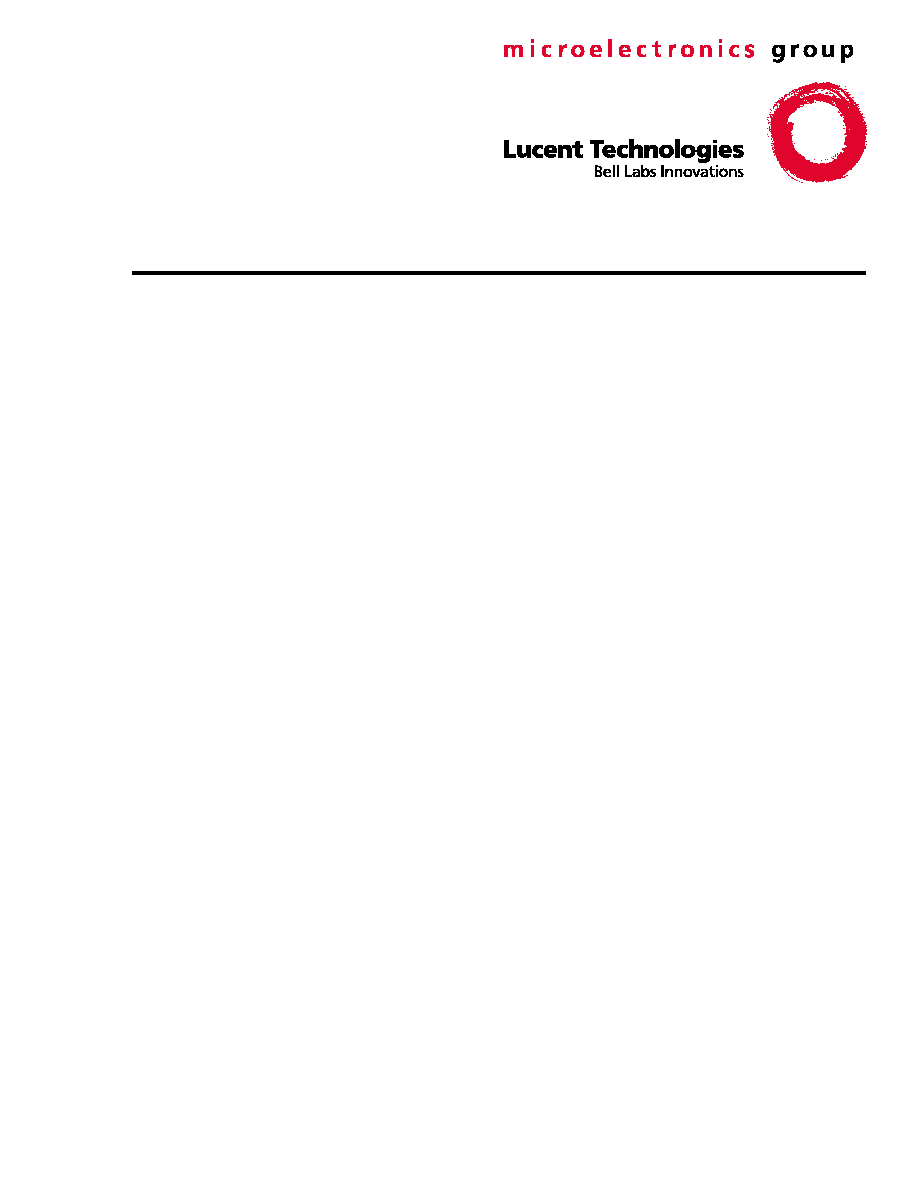
LU3X54FT
QUAD-FET (Fast Ethernet Transceiver) for 10Base-T/100Base-TX/
FX
Data Sheet
July 2000
Introduction
The LU3X54FT is a four-channel, single-chip com-
plete transceiver designed specifically for dual-speed
10Base-T, 100Base-TX, and 100Base-FX repeaters
and switches. It supports simultaneous operation in
three separate
IEEE
standard modes: 10Base-T,
100Base-TX, and 100Base-FX.
Each channel implements:
s
10Base-T transceiver function of
IEEE
802.3.
s
Physical coding sublayer (PCS) of
IEEE
802.3u.
s
Physical medium attachment (PMA) of
IEEE
802.3u.
s
Autonegotiation of
IEEE
802.3u.
s
MII management of
IEEE
802.3u.
s
Physical medium dependent (PMD) of
IEEE
802.3.
The LU3X54FT supports operations over two pairs of
unshielded twisted-pair (UTP) cable (10Base-T and
100Base-TX), and over fiber-optic cable (100Base-
FX).
It has been designed with a flexible system interface
that allows configuration for optimum performance
and effortless design. The individual per-port inter-
face can be configured as 100 Mbits/s MII, 10 Mbits/s
MII, 7-pin 10 Mbits/s serial, or bused mode.
Features
10 Mbits/s Transceiver
s
Compatible with
IEEE
* 802.3 10Base-T standard
for twisted-pair cable
s
Autopolarity detection and correction
s
Adjustable squelch level for extended line length
capability (two levels)
s
Interfaces with
IEEE
802.3u media independent
interface (MII) or a serial 10 Mbits/s 7-pin interface
s
On-chip filtering eliminates the need for external
filters
s
Half- and full-duplex operations
100 Mbits/s TX Transceiver
s
Compatible with
IEEE
802.3u MII (clause 22), PCS
(clause 23), PMA (clause 24), autonegotiation
(clause 28), and PMD (clause 25) specifications
s
Scrambler/descrambler bypass
s
Encoder/decoder bypass
s
3-statable MII in 100 Mbits/s mode
s
Selectable carrier sense signal generation (CRS)
asserted during either transmission or reception in
half duplex (CRS asserted during reception only in
full duplex)
s
Selectable MII or 5-bit code group interface
s
Full- or half-duplex operations
s
Optional carrier integrity monitor (CIM)
s
On-chip filtering and adaptive equalization that
eliminates the need for external filters
*
IEEE
is a registered trademark of The Institute of Electrical and Electronics Engineers, Inc.
Note: Advisories are issued as needed to update product information. When using this data sheet for design purposes, please contact
your Lucent Technologies Microelectronics Group Account Manager to obtain the latest advisory on this product.

Table of Contents
Contents
Page
LU3X54FT
Data Sheet
QUAD-FET for 10Base-T/100Base-TX/FX
July 2000
2
Lucent Technologies Inc.
Introduction ............................................................................................................................................................... 1
Features ................................................................................................................................................................... 1
10 Mbits/s Transceiver ........................................................................................................................................... 1
100 Mbits/s TX Transceiver ................................................................................................................................... 1
100 Mbits/s FX Transceiver ................................................................................................................................... 4
General .................................................................................................................................................................. 4
Description ............................................................................................................................................................... 4
Bused MII Mode ..................................................................................................................................................... 4
Clocking ................................................................................................................................................................. 5
FX Mode ................................................................................................................................................................ 6
Functional Block Diagrams .................................................................................................................................... 7
Application Diagrams ............................................................................................................................................. 9
Block Diagrams.................................................................................................................................................... 11
Pin Information ....................................................................................................................................................... 13
Pin Diagram for Normal MII Mode ....................................................................................................................... 13
Pin Diagram for Bused MII Mode ......................................................................................................................... 14
Pin Maps .............................................................................................................................................................. 15
Pin Descriptions ................................................................................................................................................... 16
MII Station Management ........................................................................................................................................ 29
Basic Operations.................................................................................................................................................. 29
MII Management Frames ..................................................................................................................................... 29
Management Registers (MR) ............................................................................................................................... 30
Unmanaged Operations....................................................................................................................................... 40
Mode Select ......................................................................................................................................................... 40
Absolute Maximum Ratings (TA = 25
∞
C) ............................................................................................................... 41
Electrical Characteristics ........................................................................................................................................ 41
Package and Thermal Characteristics .................................................................................................................... 42
Outline Diagram ...................................................................................................................................................... 52
208-Pin SQFP ...................................................................................................................................................... 52
Tables
Page
Table 1. LU3X54FT Crystal Specifications .............................................................................................................. 6
Table 2 . LU3X54FT Pin Maps............................................................................................................................... 15
Table 3. MII/Serial Interface Pins in Normal MII Mode (Four Separate MII Ports) ................................................. 16
Table 4. MII/Serial Interface Pins in Bused MII Mode ............................................................................................ 18
Table 5. MII Management Pins .............................................................................................................................. 22
Table 6. 10/100 Mbits/s Twisted-Pair (TP) Interface Pins....................................................................................... 22
Table 7. Miscellaneous Pins .................................................................................................................................. 23
Table 8. MII Management Frame Format............................................................................................................... 29
Table 9. MII Management Frames Field Descriptions............................................................................................ 29
Table 10. MII Management Registers (MR) ........................................................................................................... 30
Table 11. MR0--Control Register Bit Descriptions ................................................................................................ 31
Table 12. MR1--Status Register Bit Descriptions ................................................................................................. 32
Table 13. MR2, 3--PHY Identifier Registers (1 and 2) Bit Descriptions ................................................................ 33
Table 14. MR4--Autonegotiation Advertisement Register Bit Descriptions........................................................... 33
Table 15. MR5--Autonegotiation Link Partner (LP) Ability Register (Base Page) Bit Descriptions ....................... 34
Table 16. MR5--Autonegotiation Link Partner (LP) Ability Register (Next Page) Bit Descriptions ........................ 34
Table 17. MR6--Autonegotiation Expansion Register Bit Descriptions ................................................................. 35
Table 18. MR7--Next-Page Transmit Register Bit Descriptions ............................................................................ 35

Lucent Technologies Inc.
3
Data Sheet
LU3X54FT
July 2000
QUAD-FET for 10Base-T/100Base-TX/FX
Table of Contents
Tables
Page
Table 19. MR28--Device-Specific Register 1 (Status Register) Bit Descriptions...................................................36
Table 20. MR29--Device-Specific Register 2 (100 Mbits/s Control) Bit Descriptions ............................................37
Table 21. MR30--Device-Specific Register 3 (10 Mbits/s Control) Bit Descriptions ..............................................38
Table 22. MR31--Device-Specific Register 4 (Quick Status) Bit Descriptions .......................................................39
Table 23. Output Pins .............................................................................................................................................40
Table 24. LU3X54FT Modes...................................................................................................................................40
Table 25 . Absolute Maximum Ratings ...................................................................................................................41
Table 26 . Operating Conditions .............................................................................................................................41
Table 27. dc Characteristics ...................................................................................................................................41
Table 28. Thermal Characteristics..........................................................................................................................42
Table 29. MII Management Interface Timing (25 pF Load).....................................................................................43
Table 30. MII Data Timing (25 pF Load) .................................................................................................................44
Table 31. Serial 10 Mbits/s Timing for TPIN, CRS, and RX_CLK...........................................................................46
Table 32. Serial 10 Mbits/s Timing for TX_EN, TPOUT, CRS, and RX_CLK..........................................................46
Table 33. Serial 10 Mbits/s Timing for TX_EN, TPIN, and COL .............................................................................47
Table 34. Serial 10 Mbits/s Timing for RX_CLK, CRS, RXD, TX_CLK, TX_EN, and TXD (25 pF Load)................48
Table 35. Serial 10 Mbits/s Timing for RX_CLK and TX_CLK (25 pF Load) ..........................................................49
Table 36. 100 Mbits/s MII Transmit Timing .............................................................................................................50
Table 37. 100 Mbits/s MII Receive Timing..............................................................................................................51
Figures
Page
Figure 1. LU3X54FT Device Overview .....................................................................................................................7
Figure 2. LU3X54FT Single-Channel Detail Functions ............................................................................................ 8
Figure 3. Typical Single-Channel Twisted-Pair (TP) Interface .................................................................................. 9
Figure 4. Typical Single-Channel Fiber-Optic Interface ..........................................................................................10
Figure 5. Smart 10/100 Mbits/s Bused MII Mode...................................................................................................11
Figure 6. Separate 10/100 Mbits/s Bused MII Mode ..............................................................................................12
Figure 7. LU3X54FT Pinout for Normal MII Mode..................................................................................................13
Figure 8. LU3X54FT Pinout for Bused MII Mode ...................................................................................................14
Figure 9. Thermal Characteristics ..........................................................................................................................42
Figure 10. MDIO Input Timing ................................................................................................................................43
Figure 11. MDIO Output Timing .............................................................................................................................43
Figure 12. MDIO During TA (Turnaround) of a Read Transaction ..........................................................................43
Figure 13. MII Timing Requirements for LU3X54FT ..............................................................................................45
Figure 14. Serial 10 Mbits/s Timing for TPIN, CRS, and RX_CLK .........................................................................46
Figure 15. Serial 10 Mbits/s Timing for TX_EN, TPOUT, CRS, and RX_CLK........................................................46
Figure 16. Serial 10 Mbits/s Timing for TX_EN, TPIN, and COL ...........................................................................47
Figure 17. Serial 10 Mbits/s Timing for RX_CLK, CRS, RXD, TX_CLK, TX_EN, and TXD ...................................48
Figure 18. Serial 10 Mbits/s Timing Diagram for RX_CLK and TX_CLK ...............................................................49
Figure 19. 100 Mbits/s MII Transmit Timing ...........................................................................................................50
Figure 20. 100 Mbits/s MII Receive Timing ............................................................................................................51
(continued)

4
Lucent Technologies Inc.
LU3X54FT
Data Sheet
QUAD-FET for 10Base-T/100Base-TX/FX
July 2000
Features
(continued)
100 Mbits/s FX Transceiver
s
Compatible with
IEEE
802.3U 100Base-FX standard
s
Reuses existing twisted-pair I/O pins for compatible
fiber-optic transceiver pseudo-ECL (PECL) data:
-- No additional data pins required
-- Reuses existing LU3X54FT pins for fiber-optic sig-
nal detect (FOSD) inputs
s
Fiber mode automatically configures port:
-- Disables autonegotiation
-- Disables 10Base-T
-- Enables 100Base-FX remote fault signaling
-- Disables MLT-3 encoder/decoder
-- Disables scrambler/descrambler
s
FX mode enable is pin- or register-selectable on an
individual per-port basis.
General
s
Autonegotiation (
IEEE
802.3u, clause 28):
-- Fast link pulse (FLP) burst generator
-- Arbitration function
s
Bused interfaces:
-- Supports either separate 10 Mbits/s and
100 Mbits/s multiport repeaters (100 Mbits/s
MII and 10 Mbits/s serial data stream), or single-
chip multispeed repeaters
-- Connects ports to either the 10 Mbits/s or
100 Mbits/s buses controlled by autonegotiation
-- Separate TX_EN, RX_EN, CRS, and COL pins for
each port
-- Drivers on bused signal can drive up to eight
LU3X54FTs (32 ports)
s
Supports the station management protocol and
frame format (clause 22):
-- Basic and extended registers
-- Supports next-page function
-- Operates up to 12.5 MHz
-- Accepts preamble suppression
-- Maskable status interrupts
s
Supports the following management functions via
pins if MII station management is unavailable:
-- Speed select
-- Carrier integrity enable
-- Encoder/decoder bypass
-- Scrambler/descrambler bypass
-- Full duplex
-- No link pulse mode
-- Carrier sense select
-- Autonegotiation
-- 10 Mbits/s repeater reference select
-- Internal 20 MHz clock synthesizer
-- FX mode select
s
Single 25 MHz crystal input or 25 MHz clock input,
optional 20 MHz clock input
s
Supports half- and full-duplex operations
s
Provides six status signals:
-- Receive activity
-- Transmit activity
-- Full duplex
-- Collision/jabber
-- Link integrity
-- Speed indication
s
Optional LED pulse stretching
s
Per-channel powerdown mode for 10 Mbits/s and
100 Mbits/s operation
s
Loopback for 10 Mbits/s and 100 Mbits/s operation
s
Internal pull-up or pull-down resistors to set default
powerup mode
s
0.35
µ
m,
low-power CMOS technology
s
208-pin SQFP or 208-pin SQFPH
s
Single 5 V power supply
Description
Bused MII Mode
The LU3X54FT has been designed for operation in two
basic system interface modes of operation:
s
Normal MII Mode (Four Separate MII Ports). The
separate mode provides four independent RJ-45 to
MII ports and is similar to having four independent
10/100 transceivers.
s
Bused MII Mode. This mode is designed specifically
for repeater applications to save pins. In bused
mode:
-- Data from all of the ports operating at 100 Mbits/s
will be internally bused to system interface port A
(100 Mbits/s MII interface).
-- Data from all of the ports operating at 10 Mbits/s
will be internally bused to system interface port B
(7-pin 10 Mbits/s serial interface).
The LU3X54FT will automatically detect the speed of
each port (10 Mbits/s or 100 Mbits/s) and route the
data to the appropriate port.

Lucent Technologies Inc.
5
Data Sheet
LU3X54FT
July 2000
QUAD-FET for 10Base-T/100Base-TX/FX
Description
(continued)
Bused MII Mode
(continued)
The bused mode has two additional submodes of
operation:
s
Separate Bused MII Mode. This mode is designed
to operate with two independent repeater ICs, one
repeater operating at 100 Mbits/s and the other oper-
ating at 10 Mbits/s.
Figure 6 shows a block diagram of this mode in which
separate pins (four of each) are used for COL_10(4),
COL_100(4), CRS_10(4), CRS_100(4),
RX_EN10(4), RX_EN100(4), TX_EN10 (4), and
TX_EN100(4).
The signals RX_CLK10, RXD_10, TX_CLK10, and
TXD_10 (all from ports A, B, C, and D) are internally
bused together and connected to MII port B.
The signals TX_CLK25, TXD_100[3:0], TX_ER,
RX_CLK25, RXD_100[3:0], RX_DV, and RX_ER (all
from ports A, B, C, D) are internally bused together
and connected to MII port A.
The repeater ICs will enable the particular port to
which it will communicate by enabling the port with
TX_EN 10, TX_EN100, RX_EN10, or RX_EN100.
s
Smart Bused MII Mode. This mode is used when
the LU3X54FT is communicating with a single
(smart) 10/100 Mbits/s repeater IC, and allows the
use of the security feature.
Figure 5 shows a block diagram of the smart bused
mode of operation. In this mode, a common set of
pins is used for CRS10/100, RX_EN10/100,
TX_EN10/100, and COL_10/100.
The 10 Mbits/s (7-pin 10 Mbits/s serial interface) sig-
nals are still routed to port B (RX_CLK10, RXD_10,
TX_CLK10, and TXD_10).
The 100 Mbits/s signals are still routed to port A
(TX_CLK25, TXD_100[3:0], TX_ER, RX_CLK25,
RXD_100[3:0], RX_DV, and RX_ER).
The bused interface allows each of the four transceiv-
ers to be connected to one of two system interfaces:
s
Port A: 100 Mbits/s MII interface.
s
Port B: 7-pin 10 Mbits/s serial interface.
This configuration allows 10/100 Mbits/s segment seg-
regation or port switching with conventional multiport
shared-media repeaters.
The port speed configuration and connection to the
appropriate bused output is done automatically and is
controlled by autonegotiation.
Figure 1 gives a functional overview of the LU3X54FT
while Figure 2 details its single-channel functions.
Figure 3 shows how the LU3X54FT single channel
interfaces to the twisted pair (TP).
Clocking
The LU3X54FT requires an internal 25 MHz clock and
a 20 MHz clock to run the 100Base-TX transceiver and
10Base-T transceiver.
These clocks can be supplied as follows:
s
As separate clock inputs: 25 MHz and 20 MHz.
s
The 20 MHz clock can be internally synthesized from
the 25 MHz clock.
s
The 25 MHz clock can also be internally generated
by an on-chip oscillator if an external crystal is sup-
plied.
The LU3X54FT will automatically detect if a 25 MHz
clock is supplied, or if a crystal is being used to gener-
ate the 25 MHz clock.

6
Lucent Technologies Inc.
LU3X54FT
Data Sheet
QUAD-FET for 10Base-T/100Base-TX/FX
July 2000
Description
(continued)
Clocking
(continued)
Either the on-chip 20 MHz clock synthesizer (default
clock) can be used, or H-DUPLED[A]/CLK20_SEL
(pin 198) can be pulled high (sensed on powerup and
reset) to select the external 20 MHz clock input.
The crystal specifications for the device are listed in
Table 1, and the crystal circuit is shown in Figure 3 and
Figure 4.
Table 1. LU3X54FT Crystal Specifications
FX Mode
Each individual port of the LU3X54FT can be operated
in 100Base-FX mode by selecting it through the pin
program option (RXLED[D:A]/FX_MODE_EN[D:A], or
through the register bit (register 29, bit 0). FX mode
can operate in full or half duplex. Each individual chan-
nel's duplex can be set by register zero bit eight (0.8) or
all ports duplex can be hardware configured at power
up or rest by pin 201 FULL_DUP.
When operating in FX mode, the twisted-pair I/O pins
are reused as the fiber-optic transceiver I/O data pins,
and the fiber-optic signal detect (FOSD) inputs are
enabled.
Figure 4 shows a typical FX port interface. Note that no
additional external components, excluding those
needed by the fiber transceiver, are required.
When a port is placed in FX mode, it will automatically
configure the port for 100Base-FX operation (and the
register bit control will be ignored) such that:
s
The far-end fault signaling option will be enabled.
s
The MLT-3 encoding/decoding will be disabled.
s
Scrambler/descrambler will be disabled.
s
Autonegotiation will be disabled.
s
The signal detect inputs will be activated.
s
10Base-T will be disabled.
Parameter
Requirement
Type
Quartz Fundamental Mode
Frequency
25 MHz
Stability
±25 ppm, 0 ∞C--70 ∞C
Shunt Capacitor
7 pF
Load Capacitor
20 pF
Series Resistance
<30

Lucent Technologies Inc.
7
Data Sheet
LU3X54FT
July 2000
QUAD-FET for 10Base-T/100Base-TX/FX
Description
(continued)
Functional Block Diagrams
Device Overview
5-5137(F).fr2
Figure 1. LU3X54FT Device Overview
10 Mbits/s TRANSCEIVER
AUTONEGOTIATION
PMA
PMA
PMA
PMA
TX PMD/
MUX
MANAGEMENT
PCS
MANAGEMENT
PCS
MANAGEMENT
PCS
MANAGEMENT
PCS
MII/SERIAL
AUTONEGOTIATION
AUTONEGOTIATION
AUTONEGOTIATION
MUX
MUX
MUX
DPLL
10 MHz
25 MHz
125 MHz
LSCLK
INTERFACE
MII/SERIAL
INTERFACE
MII/SERIAL
INTERFACE
MII/SERIAL
INTERFACE
20 MHz
25 MHz
DRIVER AND FILTERS
10 Mbits/s TRANSCEIVER
DRIVER AND FILTERS
10 Mbits/s TRANSCEIVER
DRIVER AND FILTERS
10 Mbits/s TRANSCEIVER
DRIVER AND FILTERS
DRIVER AND
FILTERS
DRIVER AND
FILTERS
DRIVER AND
FILTERS
DRIVER AND
FILTERS
TP
MAGNETICS
INTERFACE
20 MHz
25 MHz
CRYSTAL
FX PORT
FX_MODE_EN
TX PMD/
FX PORT
TX PMD/
FX PORT
TX PMD/
FX PORT
FX_MODE_EN
FX_MODE_EN
FX_MODE_EN
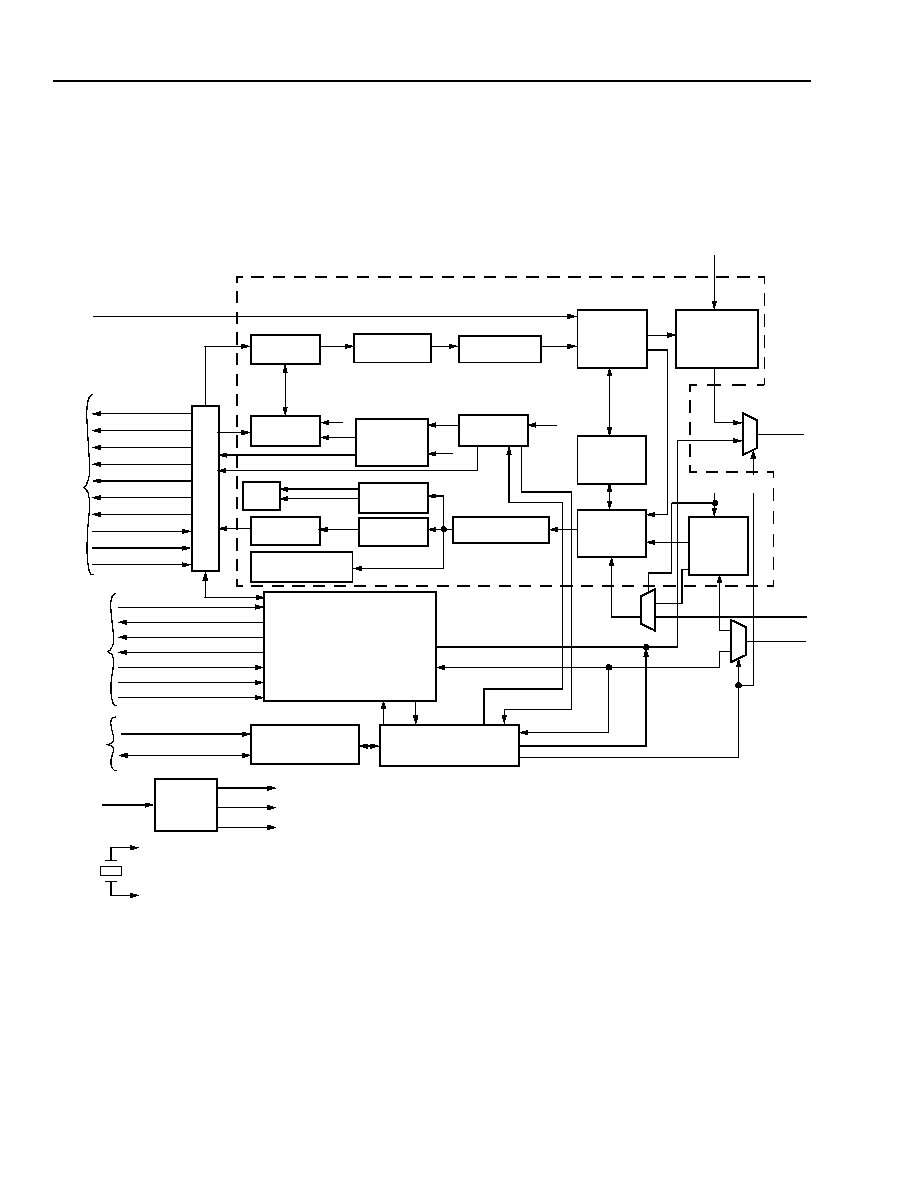
LU3X54FT
Data Sheet
QUAD-FET for 10Base-T/100Base-TX/FX
July 2000
8
Lucent Technologies Inc.
Description
(continued)
Functional Block Diagrams
(continued)
Single-Channel Detail Functions
5-5136(F).gr4
Figure 2. LU3X54FT Single-Channel Detail Functions
AUTONEGOTIATION
AND LINK MONITOR
100 OFF
TXD[3:0]
4B/5B
ENCODER
FAR-END
FAULT GEN
SCRAMBLER
PDT
DCRU
SD
PDR
DESCRAMBLER
ALIGNER
5B/4B
DECODER
FAR-END
FAULT DETECT
10 Mbits/s TRANSCEIVER
RX_CLK
RXD[0]
TX_CLK
TX_EN
TXD[0]
CLK20
MDC
MDIO
MII
TPIN
±
TX STATE
MACHINE
SD
COLLISION
DETECT
SD
RX STATE
MACHINE
MII
TX_ER/TXD[4]
TX_EN
TXD[3:0]
TX_CLK
RX_CLK
RX_ER/RXD[4]
RX_DV
RXD[3:0]
COL
CRS
REF10
MANAGEMENT
25 MHz
125 MHz
LSCLK
PMD
TX/
PMD
RX/
SD
TPOUT
±
100 Mbits/s TRANSCEIVER
LC10 LS10
LC100
LS100
CARRIER
CIM
DETECT
RXERR_ST
CAR_STAT
MI
I
IN
T
E
R
F
A
C
E
SE
RIA
L
IN
T
E
R
F
A
C
E
DPLL
25 MH
Z
M
A
NA
G
E
ME
NT
I
N
TE
RF
ACE
20 MHz
25 MHz
CRYSTAL
FIBER PORT
FX_MODE_EN
FX_MODE_EN
FIBER
PORT
FOSD
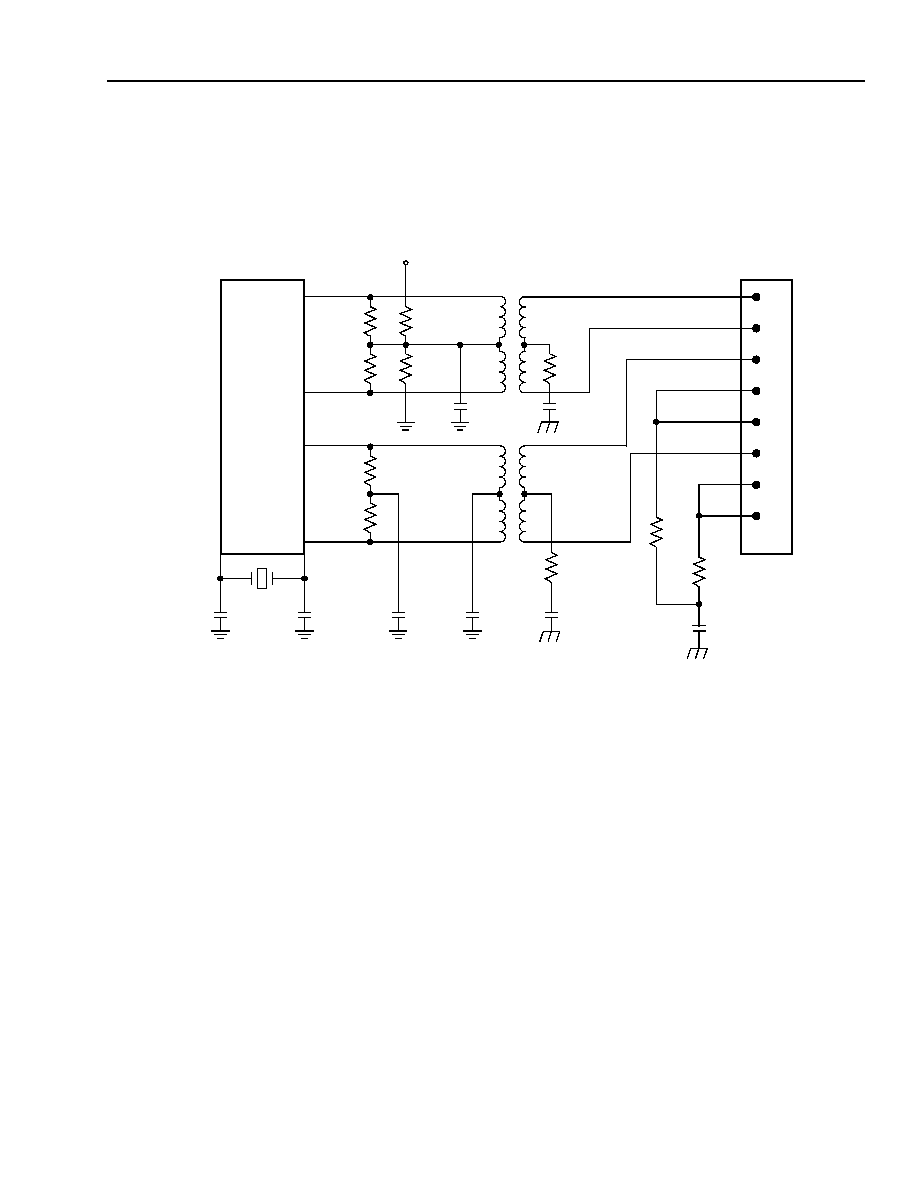
Lucent Technologies Inc.
9
Data Sheet
LU3X54FT
July 2000
QUAD-FET for 10Base-T/100Base-TX/FX
Description
(continued)
Application Diagrams
Single-Channel Twisted-Pair Interface
5-5433(F).r9
Figure 3. Typical Single-Channel Twisted-Pair (TP) Interface
LU3X54FT
RJ-45
1
2
3
4
5
6
7
8
75
75
0.01
µ
F
1:1
1:1
0.01
µ
F
0.01
µ
F
0.01
µ
F
220
TPIN+
TPIN≠
TPOUT+
TPOUT≠
220
50
50
V
DDO
75
0.01
µ
F
75
X
T
ALO
U
T
XTA
L
IN
88
87
33 pF
33 pF
25 MHz
50
50
0.01
µ
F

LU3X54FT
Data Sheet
QUAD-FET for 10Base-T/100Base-TX/FX
July 2000
10
Lucent Technologies Inc.
Description
(continued)
Application Diagrams
(continued)
Single-Channel Fiber-Optic Interface
5-5433(F).dr2
Figure 4. Typical Single-Channel Fiber-Optic Interface
LU3X54FT
TD
TDN
SD
RD
RDN
0.01
µ
F
220
TPIN+
TPIN≠
TPOUT+
TPOUT≠
220
50
50
V
DDO
82
0.01
µ
F
130
XT
ALO
U
T
XT
ALI
N
88
87
33 pF
33 pF
25 MHz
FOSD
50
50
82
130
82
130
V
DDA
0.01
µ
F
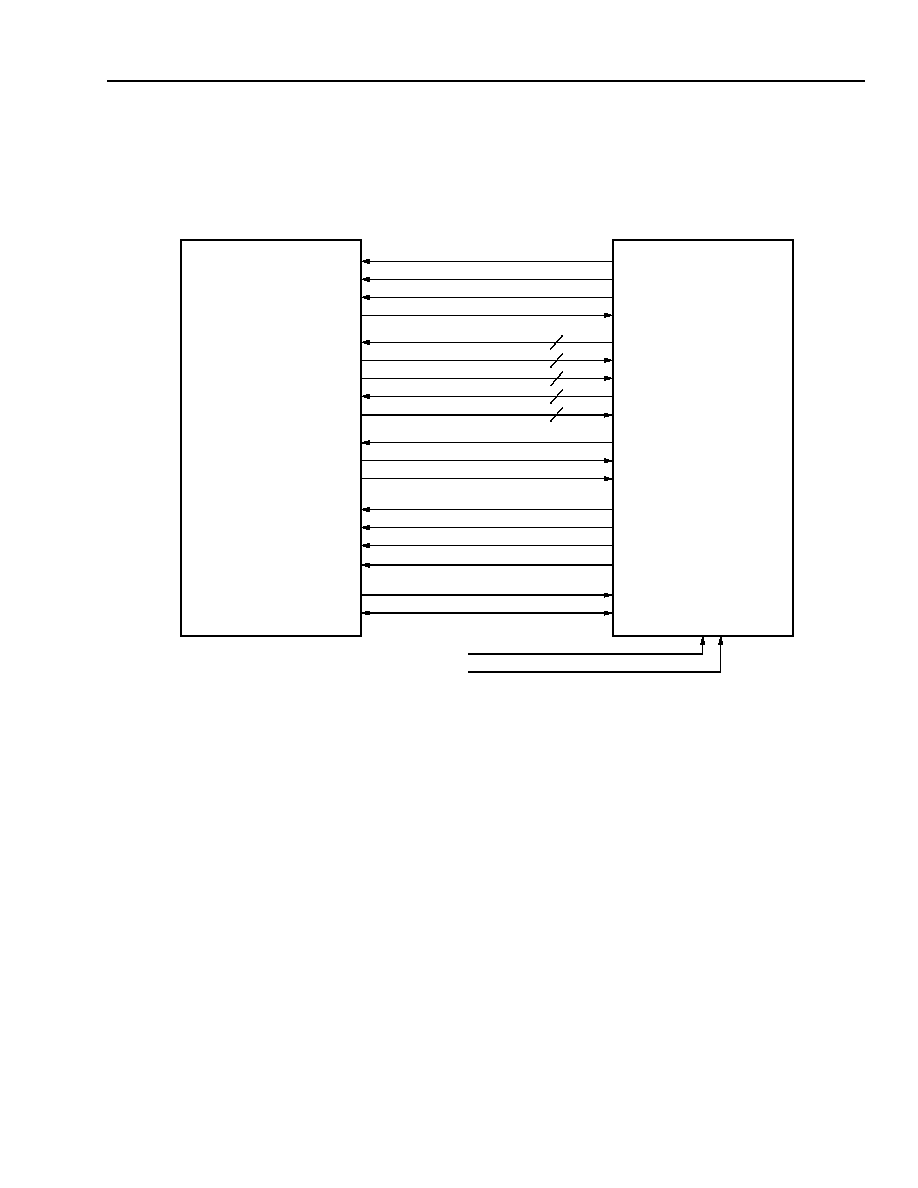
Lucent Technologies Inc.
11
Data Sheet
LU3X54FT
July 2000
QUAD-FET for 10Base-T/100Base-TX/FX
Description
(continued)
Block Diagrams
Smart Bused MII Mode
5-5599.br2
Figure 5. Smart 10/100 Mbits/s Bused MII Mode
RX_CLK10
RXD_10
TX_CLK10
TXD_10
COL_100
CRS_100
RX_EN100
TX_EN100
TX_EN10/SECURITY
TX_CLK25
TXD_100[3:0]
TX_ER
RX_CLK25
RXD_100[3:0]
RX_DV
RX_ER
MDC
MDIO
SMART_MODE_SELECT
BUSED_MII_MODE
LU3X54FT
10/100 Mbits/s
REPEATER
RX_CLK10
RXD_10
TX_CLK10
TXD_10
COL_10/100
CRS_10/100
RX_EN10/100
TX_EN10/100
SECURITY10/100
TX_CLK25
TXD_100[3:0]
TX_ER
RX_CLK25
RXD_100[3:0]
RX_DV
RX_ER
MDC
MDIO
SMART
4
4
4
4
4
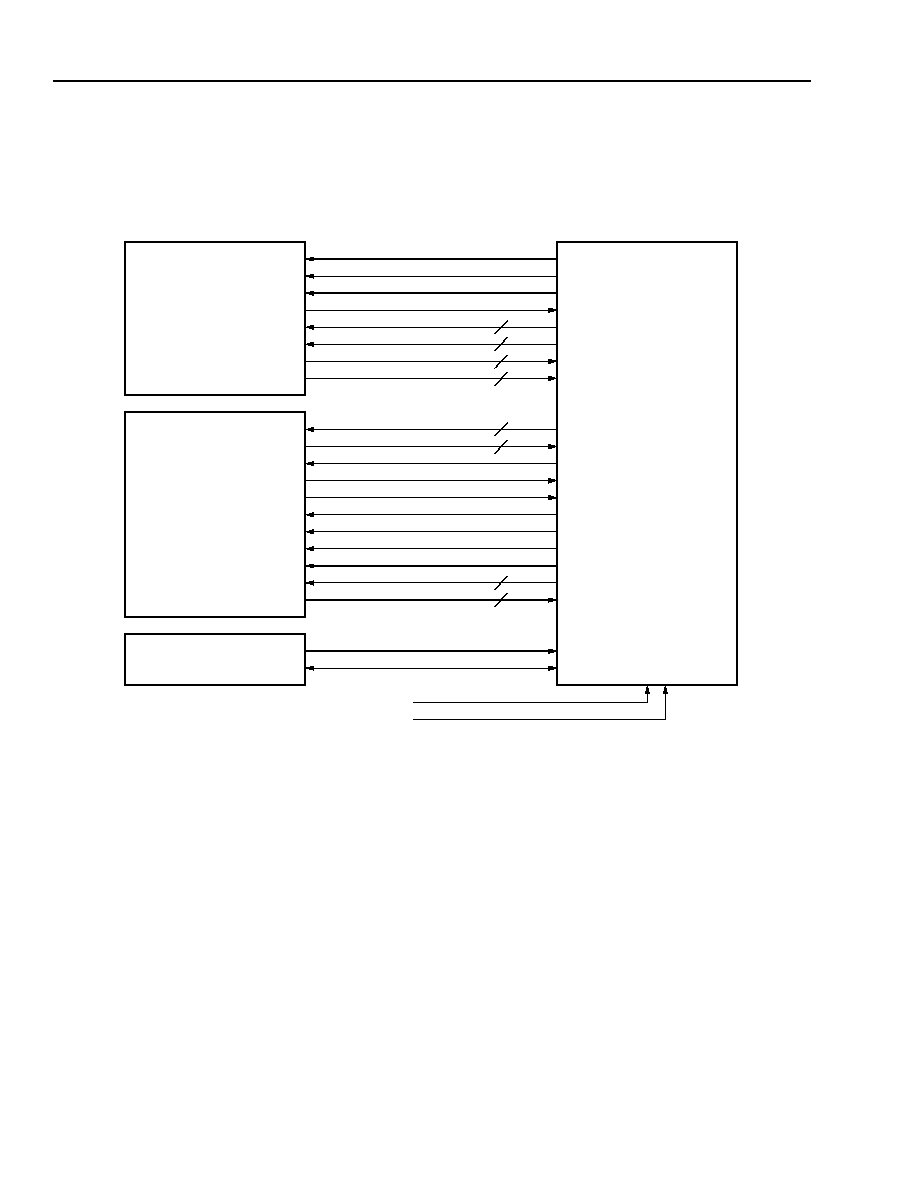
LU3X54FT
Data Sheet
QUAD-FET for 10Base-T/100Base-TX/FX
July 2000
12
Lucent Technologies Inc.
Description
(continued)
Block Diagrams
(continued)
Separate Bused MII Mode
5-5599.ar5
Figure 6. Separate 10/100 Mbits/s Bused MII Mode
RX_CLK10
RXD_10
TX_CLK10
TXD_10
COL_10
CRS_10
RX_EN10
TX_EN10
CRS_100
TX_EN100
TX_CLK25
TXD_100[3:0]
TX_ER
RX_CLK25
RXD_100[3:0]
RX_DV
RX_ER
COL_100
RX_EN100
MDC
MDIO
SMART_MODE_SELECT
BUSED_MII_MODE
LU3X54FT
10 Mbits/s
REPEATER
100 Mbits/s
REPEATER
MANAGEMENT
RX_CLK10
RXD_10
TX_CLK10
TXD_10
COL_10
CRS_10
RX_EN10
TX_EN10
CRS_100
TX_EN100
TX_CLK25
TXD_100[3:0]
TX_ER
RX_CLK25
RXD_100[3:0]
RX_DV
RX_ER
COL_100
RX_EN100
MDC
MDIO
4
4
4
4
4
4
4
4

Lucent Technologies Inc.
13
Data Sheet
LU3X54FT
July 2000
QUAD-FET for 10Base-T/100Base-TX/FX
Pin Information
Pin Diagram for Normal MII Mode
5-5616(F).ar4
Figure 7. LU3X54FT Pinout for Normal MII Mode
VSS
156
RXD[0][B]
155
RX_CLK[B]
154
RX_ER[B]/RXD[4][B]
153
VDD
152
RX_DV[B]
151
COL[B]
150
CRS[B]
149
TX_CLK[B]
148
VSS
147
TX_EN[B]
146
TX_ER[B]/TXD[4][B]
145
VDD
144
TXD[3][B]
143
TXD[2][B]
142
VSS
141
TXD[1][B]
140
TXD[0][B]
139
MII_EN[A]
138
VDD
137
RXD[3][A]
136
RXD[2][A]
135
RXD[1][A]
134
VSS
133
RXD[0][A]
132
RX_CLK[A]
131
RX_ER[A]/RXD[4][A]
130
VDD
129
RX_DV[A]
128
COL[A]
127
CRS[A]
126
TX_CLK[A]
125
VSS
124
TX_EN[A]
123
TX_ER[A]/TXD[4][A]
122
VDD
121
TXD[3][A]
120
TXD[2][A]
119
VSS
118
TXD[1][A]
117
TXD[0][A]
116
VSS
115
REF10
114
MDC
113
MDIO
112
VDD
111
MII_EN[D]
110
RXD[3][D]
109
RXD[2][D]
108
RXD[1][D]
107
VSS
106
RXD[0][D]
105
GNDA
1
FOSD[C]
2
FOSD[D]
3
VDDA
4
TPIN+/FOIN+[D]
5
TPIN≠/FOIN≠[D]
6
GNDA
7
VDDA
8
TPIN+/FOIN+[C]
9
TPIN≠/FOIN≠[C]
10
GNDA
11
VDDA
12
BGREF0
13
GNDA
14
VDDA
15
TPIN+/FOIN+[B]
16
TPIN≠/FOIN≠[B]
17
GNDA
18
VDDA
19
TPIN+/FOIN+[A]
20
TPIN≠/FOIN≠[A]
21
GNDA
22
VDDA
23
GNDA
24
BGREF1
25
GNDD
26
CLK20
27
VDDD
28
GNDAA
29
VDDAA
30
GNDO
31
TPOUT+/FOOUT+[D]
32
TPOUT≠/FOOUT≠[D]
33
VDDO
34
GNDO
35
TPOUT+/FOOUT+[C]
36
TPOUT≠/FOOUT≠[C]
37
VDDO
38
GNDM
39
VDDM
40
GNDAP
41
ISET_10
42
ISET_100
43
VDDAP
44
GNDO
45
TPOUT+/FOOUT+[B]
46
TPOUT≠/FOOUT≠[B]
47
VDDO
48
GNDO
49
TPOUT+/FOOUT+[A]
50
TPOUT≠/FOOUT≠[A]
51
VDDO
52
RX
_
C
L
K
[D]
10
4
R
X
_
E
R[
D]
/
R
XD
[
4
]
[
D
]
10
3
VDD
10
2
RX
_
D
V[D]
10
1
COL
[
D
]
10
0
CRS
[
D
]
99
TX
_C
L
K
[
D
]
98
VS
S
97
T
X
_
E
N[
D]
96
T
X
_
E
R[D]T
X
D[4
]
[D]
95
VDD
94
TX
D
[
3]
[
D
]
93
TX
D
[
2]
[
D
]
92
VS
S
91
TX
D
[
1]
[
D
]
90
TX
D
[
0]
[
D
]
89
XT
AL
O
U
T
88
L
S
C
L
K
/
XT
AL
I
N
87
VS
SPD
86
FO
S
D
[
B
]
85
FO
S
D
[
A
]
84
VDDPD
83
VSS
PL
L
82
CKR
E
F
81
VDDP
L
L
80
VS
S
79
MI
I_E
N
[
C
]
78
VDD
77
RX
D
[
3
]
[
C
]
76
RX
D
[
2
]
[
C
]
75
RX
D
[
1
]
[
C
]
74
VS
S
73
RX
D
[
0
]
[
C
]
72
RX
_
C
L
K
[C]
71
R
X
_
E
R[
C]
/
R
XD
[
4
]
[
C
]
70
VDD
69
RX
_
D
V[C]
68
COL
[
C
]
67
CRS
[
C
]
66
TX
_C
L
K
[
C
]
65
VS
S
64
T
X
_
E
N[
C]
63
T
X
_E
R[C]/T
X
D
[4]
[
C]
62
VDD
61
TX
D
[
3]
[
C
]
60
TX
D
[
2]
[
C
]
59
VS
S
58
TX
D
[
1]
[
C
]
57
TX
D
[
0]
[
C
]
56
MO
D
E
[4]
55
NC
54
M
ASK
_
S
T
A
T_
I
N
T
53
RX
D
[
1
]
[
B
]
157
RX
D
[
2
]
[
B
]
158
RX
D
[
3
]
[
B
]
159
VD
D
160
MII_E
N
[B
]
161
TX
LE
D
[
A
]/R
E
F
_S
E
L
162
VS
S
163
T
X
L
E
D[B
]/SCRAM
_
DESC
_
B
YP
A
S
S
164
T
X
L
E
D[C]/E
NC_
DEC_
BYP
AS
S
165
T
X
LE
D[D]/CA
R
IN_E
N
166
VD
D
167
R
X
L
E
D[A]/F
X_
M
O
DE
_
E
N[A]
168
R
X
L
E
D[B]/F
X_
M
O
DE
_
E
N[B]
169
RX
L
E
D
[
C
]
/
F
X_
M
O
D
E
_
E
N[
C]
170
RX
L
E
D
[
D
]
/
F
X_
M
O
D
E
_
E
N[
D]
171
VD
D
172
CO
L
E
D
[
A]
173
CO
L
E
D
[
B]
174
CO
L
E
D
[
C]
175
CO
L
E
D
[
D]
176
VS
S
177
GNDC
178
V
DDC
179
V
DDC
180
GNDC
181
GND
A
182
A
T
ES
T[
A]
183
A
T
ES
T[
B]
184
VD
D
A
185
VS
S
186
LINK
L
E
D[A
]/NO_
LP
187
L
I
NK
L
E
D[B]/PHY
AD
D[0
]
188
L
I
NK
L
E
D[C]/PHY
ADD[1
]
189
L
I
NK
L
E
D[D]/
P
HY
ADD[2
]
190
S
P
E
E
DLE
D
[A
]/IS
OLA
T
E
_
MO
D
E
191
S
P
E
E
DLE
D
[B
]/B
US
E
D
_
M
II_M
O
DE
192
S
P
E
E
DLE
D
[C]/S
MA
R
T
_M
ODE
_
S
E
LE
CT
193
S
PEE
DL
ED[
D
]
/
SPE
ED
194
VD
D
195
3S
T
_
E
N
196
AU
TO
_
E
N
197
H
_
D
U
P
LE
D
[
A
]/C
LK
20_S
E
L
198
H
_
DUP
L
E
D[B]/CRS_
S
EL
199
H
_
DUP
L
E
D[C]/SERIA
L
_
S
E
L
200
H
_
DUP
L
E
D[D]/F
UL
L
_
DUP
201
VD
D
202
R
ESE
T
203
MOD
E
[0]
204
MOD
E
[1]
205
MOD
E
[2]
206
MOD
E
[3]
207
VS
S
208
LU3X54FT
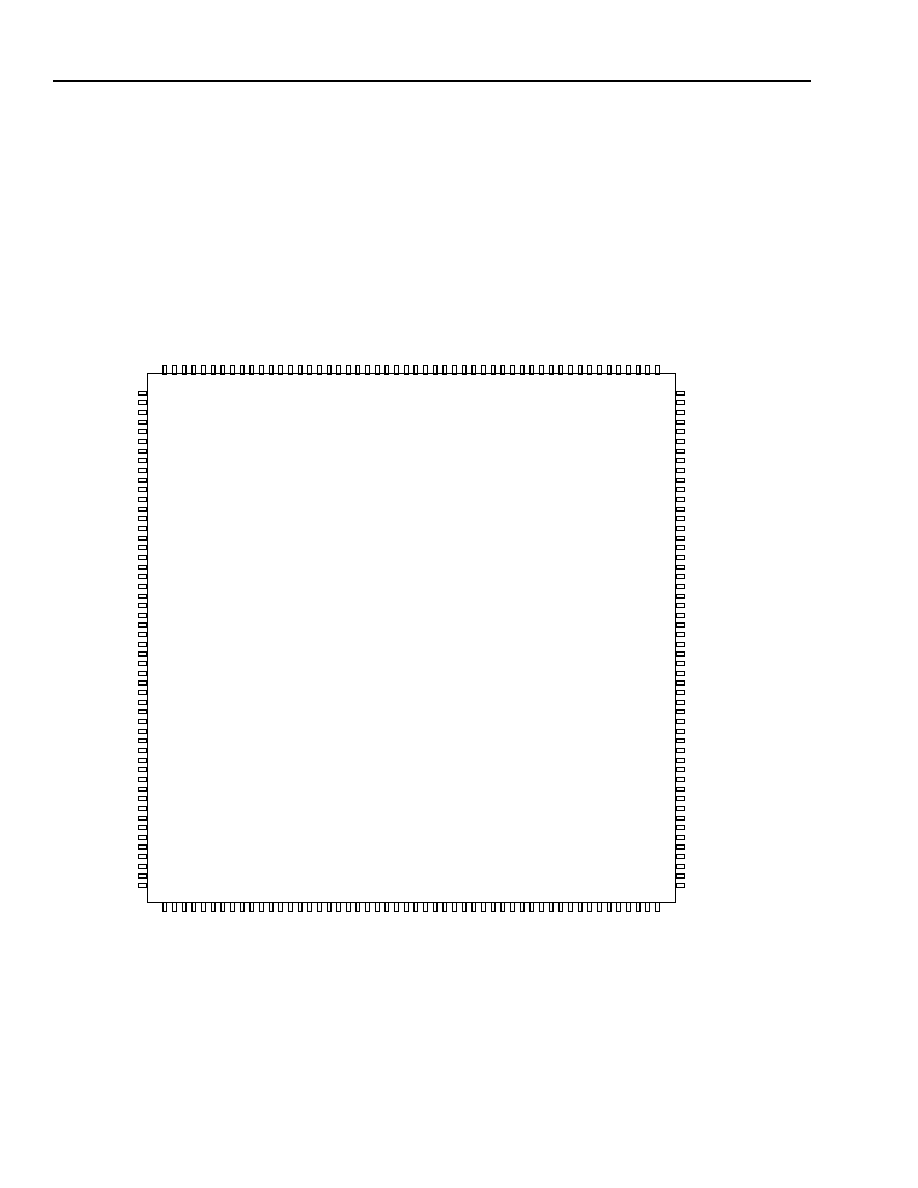
LU3X54FT
Data Sheet
QUAD-FET for 10Base-T/100Base-TX/FX
July 2000
14
Lucent Technologies Inc.
Pin Information
(continued)
Pin Diagram for Bused MII Mode
5-5616(F).br2
Figure 8. LU3X54FT Pinout for Bused MII Mode
VSS
156
RXD_10
155
RX_CLK10
154
NC
153
VDD
152
NC
151
COL_100[B]/COL_10/100[B]
150
CRS_100[B]/CRS_10/100[B]
149
TX_CLK10
148
VSS
147
TX_EN100[B]/TX_EN10/100
146
NC
145
VDD
144
NC
143
NC
142
VSS
141
NC
140
TXD_10
139
RX_EN100[A]/RX_EN10/100[A
138
VDD
137
RXD_100[3]
136
RXD_100[2]
135
RXD_100[1]
134
VSS
133
RXD_100[0]
132
RX_CLK25
131
RX_ER
130
VDD
129
RX_DV
128
COL_100[A]/COL_10/100[A]
127
CRS_100[A]/CRS_10/100[A]
126
TX_CLK25
125
VSS
124
TX_EN100[A]/TX_EN10/100
123
TX_ER
122
VDD
121
TXD_100[3]
120
TXD_100[2]
119
VSS
118
TXD_100[1]
117
TXD_100[0]
116
VSS
115
REF10
114
MDC
113
MDIO
112
VDD
111
RX_EN100[D]/RX_EN10/100[D
110
CRS_10[D]
109
CRS_10[C]
108
CRS_10[B]
107
VSS
106
CRS_10[A]
105
GNDA
1
FOSD[C]
2
FOSD[D]
3
VDDA
4
TPIN+/FOIN+[D]
5
TPIN≠/FOIN≠[D]
6
GNDA
7
VDDA
8
TPIN+/FOIN+[C]
9
TPIN≠/FOIN≠[C]
10
GNDA
11
VDDA
12
BGREF0
13
GNDA
14
VDDA
15
TPIN+/FOIN+[B]
16
TPIN≠/FOIN≠[B]
17
GNDA
18
VDDA
19
TPIN+/FOIN+[A]
20
TPIN≠/FOIN≠[A]
21
GNDA
22
VDDA
23
GNDA
24
BGREF1
25
GNDD
26
CLK20
27
VDDD
28
GNDAA
29
VDDAA
30
GNDO
31
POUT+/FOOUT+[D]
32
POUT≠/FOOUT≠[D]
33
VDDO
34
GNDO
35
POUT+/FOOUT+[C]
36
POUT≠/FOOUT≠[C]
37
VDDO
38
GNDM
39
VDDM
40
GNDAP
41
ISET_10
42
ISET_100
43
VDDAP
44
GNDO
45
POUT+/FOOUT+[B]
46
POUT≠/FOOUT≠[B]
47
VDDO
48
GNDO
49
POUT+/FOOUT+[A]
50
POUT≠/FOOUT≠[A]
51
VDDO
52
NC
104
NC
103
VD
D
102
NC
101
C
O
L
_100
[D
]/C
OL_10
/100[
D
]
100
C
R
S
_
100[D
]
/
C
R
S
_10
/100[
D
]
99
NC
98
VSS
97
TX
_E
N
100[D
]/T
X
_
E
N
1
0
/100
96
NC
95
VD
D
94
T
X
_
E
N1
0
[
D]/SE
CURIT
Y
_
1
0
/
1
0
0
93
T
X
_
E
N1
0
[
C]/SE
CURIT
Y
_
1
0
/
1
0
0
92
VSS
91
T
X
_
E
N
1
0
[
B]/SE
CURIT
Y
_
1
0
/
1
0
0
90
T
X
_
E
N
1
0
[
A]/SE
CURIT
Y
_
1
0
/
1
0
0
89
XT
AL
O
U
T
88
L
S
CL
K
/
XT
AL
I
N
87
V
SSP
D
86
FO
S
D
[
B
]
85
FO
S
D
[
A
]
84
VDDP
D
83
VS
SPL
L
82
CK
REF
81
V
DDPL
L
80
VSS
79
R
X
_E
N
100
[C
]/R
X
_
E
N
10
/100[
C
]
78
VD
D
77
C
O
L
_10[D
]
76
C
O
L
_10[C
]
75
C
O
L_10[
B
]
74
VSS
73
C
O
L_10[
A
]
72
NC
71
NC
70
VD
D
69
NC
68
C
O
L
_100
[C
]/C
OL_10
/100[
C
]
67
C
R
S
_
100[C
]
/
C
R
S
_10
/100[
C
]
66
NC
65
VSS
64
TX
_E
N
100[C
]/T
X
_
E
N
1
0
/100
63
NC
62
VD
D
61
R
X
_E
N
10[D
]
60
R
X
_E
N
10[C
]
59
VSS
58
R
X
_E
N
10[
B
]
57
R
X
_E
N
10[
A
]
56
MOD
E
[4]
55
NC
54
MA
S
K
_S
T
A
T
_
IN
T
53
NC
157
NC
158
NC
159
VDD
160
R
X
_E
N
1
00[B
]/R
X
_
E
N
1
0
/100
[B
]
161
TX
L
E
D[
A]
/
R
EF
_
SEL
162
VSS
163
T
X
L
E
D[B
]
/
S
CRAM
_
DESC
_
B
YP
A
S
S
164
T
X
L
E
D[C]/ENC_
DEC_
BY
P
A
SS
165
T
X
L
E
D[D]/CA
R
IN_E
N
166
VDD
167
RXL
E
D[A
]
/F
X_
M
O
DE_
E
N[A]
168
RXL
E
D[B
]
/F
X_
M
O
DE_
E
N[B]
169
RXL
E
D[C]/F
X_
M
O
DE
_
E
N[C]
170
RXL
E
D[D]/F
X
_
M
O
DE
_
E
N[D]
171
VDD
172
COL
E
D[A]
173
COL
E
D[B]
174
COL
E
D[C]
175
COL
E
D[D]
176
VSS
177
GNDC
178
VDDC
179
VDDC
180
GNDC
181
GND
A
182
A
T
EST
[
A
]
183
A
T
EST
[
B
]
184
VDD
A
185
VSS
186
LI
N
K
LE
D
[
A
]/N
O_LP
187
L
I
N
K
L
E
D[B]/PHY
A
DD[0
]
188
L
I
NKL
E
D[C]/PHY
A
DD[1
]
189
L
I
N
K
L
E
D[D]/PHY
A
DD[2
]
190
SPE
EDL
E
D[
A
]
/
I
S
O
L
A
T
E
_
M
O
DE
191
SPE
EDL
E
D[
B
]
/
B
US
ED_
M
I
I
_
M
O
D
E
192
SPE
EDL
E
D[
C]
/
S
M
A
R
T
_
M
O
D
E_
SEL
E
C
T
193
SPE
EDL
E
D[
D]
/
S
P
EED
194
VDD
195
3S
T
_
E
N
196
AU
T
O
_
E
N
197
H
_
D
U
P
LE
D
[
A
]/C
LK
20
_S
E
L
198
H_
DUPL
E
D[B
]
/CR
S
_
SEL
199
H_
DUPL
E
D[C]/SE
R
IAL
_
SEL
200
H_
DUPL
E
D[D]/F
UL
L
_
DUP
201
VDD
202
RES
E
T
203
MO
D
E
[
0
]
204
MO
D
E
[
1
]
205
MO
D
E
[
2
]
206
MO
D
E
[
3
]
207
VSS
208
LU3X54FT

Lucent Technologies Inc.
15
Data Sheet
LU3X54FT
July 2000
QUAD-FET for 10Base-T/100Base-TX/FX
Pin Information
(continued)
Pin Maps
Table 2. LU3X54FT Pin Maps
Normal Mode Pins
Bused Mode Pins
10/100 Mbits/s Smart Mode Pins
Separate Mode Pins
RXD[D][3:0]
CRS_10[D:A]
Not used
CRS_10
CRS[D:A]
CRS_100[D:A]
CRS_10 and CRS_100
CRS_100
TXD[C][3:0]
RX_EN10[D:A]
Not used
RX_EN10
MII_EN[D:A]
RX_EN100[D:A]
RX_EN10 and RX_EN100
RX_EN100
TXD[3:0][D]
TX_EN10[D:A]
SECURITY_10 and SECURITY_100
TX_EN10
TX_EN[D:A]
TX_EN100[D:A]
TX_EN10 and TX_EN100
TX_EN100
RXD[3:0][C]
COL_10[D:A]
Not used
COL_10
COL[D:A]
COL_100[D:A]
COL_10 and COL_100
COL_100
SPEEDLED[C]
SMART_MODE_SELECT
SMART_MODE_SELECT
SMART_MODE_SELECT
SPEEDLED[B]
BUSED_MII_MODE
BUSED_MII_MODE
BUSED_MII_MODE
TX_CLK[A]
TX_CLK25
TX_CLK25
TX_CLK25
TX_CLK[B]
TX_CLK10
TX_CLK10
TX_CLK10
RX_CLK[B]
RX_CLK10
RX_CLK10
RX_CLK10
RX_CLK[A]
RX_CLK25
RX_CLK25
RX_CLK25
RXD[B][0]
RXD_10
RXD_10
RXD_10
RXD[3:0][A]
RXD_100[3:0]
RXD_100
RXD_100
RX_DV[A]
RX_DV
RX_DV
RX_DV
RX_ER[A]
RX_ER
RX_ER
RX_ER
TXD[B][0]
TXD_10
TXD_10
TXD_10
TXD[A][3:0]
TXD_100[3:0]
TXD_100
TXD_100
TX_ER[A]
TX_ER
TX_ER
TX_ER

LU3X54FT
Data Sheet
QUAD-FET for 10Base-T/100Base-TX/FX
July 2000
16
Lucent Technologies Inc.
Pin Information
(continued)
Pin Descriptions
This section describes the LU3X54FT signal pins. Note that any register bit referenced includes the register num-
ber and bit position. For example, register bit [29.8] is register 29, bit 8.
Table 3. MII/Serial Interface Pins in Normal MII Mode (Four Separate MII Ports)
Pin
Signal
Type
Description
100
67
150
127
COL[D:A]
O
Collision Detect. This signal signifies in half-duplex mode that a collision
has occurred on the network. COL is asserted high whenever there is
transmit and receive activity on the UTP media. COL is the logical AND of
TX_EN and receive activity, and is an asynchronous output. When
SERIAL_SEL is high and in 10Base-T mode, this signal indicates the jab-
ber timer has expired.
99
66
149
126
CRS[D:A]
O
Carrier Sense. When CRS_SEL is low, this signal is asserted high when
either the transmit or receive medium is nonidle. This signal remains
asserted throughout a collision condition. When CRS_SEL is high, CRS is
asserted on receive activity only. CRS_SEL is set via the MII management
interface or the CRS_SEL pin.
104
71
154
131
RX_CLK[D:A]
O
Receive Clock. 25 MHz clock output in 100 Mbits/s mode, 2.5 MHz output
in 10 Mbits/s nibble mode, 10 MHz in 10 Mbits/s serial mode. RX_CLK has
a worst-case 45/55 duty cycle. RX_CLK provides the timing reference for
the transfer of RX_DV, RXD, and RX_ER signals.
109
76
159
136
108
75
158
135
107
74
157
134
105
72
155
132
RXD[3:0][D:A]
O
Receive Data. 4-bit parallel data outputs that are synchronous to RX_CLK.
When RX_ER[D:A] is asserted high in 100 Mbits/s mode, an error code will
be presented on RXD[3:0][D:A] where appropriate. The codes are as fol-
lows:
s
Packet errors: ERROR_CODES = 2h.
s
Link errors: ERROR_CODES = 3h. (Packet and link error codes will only
be repeated if registers [29.9] and [29.8] are enabled.)
s
Premature end errors: ERROR_CODES = 4h.
s
Code errors: ERROR_CODES = 5h.
When SERIAL_SEL is active-high and 10 Mbits/s mode is selected, RXD[0]
is used for data output and RXD[3:1] are 3-stated.
101
68
151
128
RX_DV[D:A]
O
Receive Data Valid. When this pin is high, it indicates the LU3X54FT is
recovering and decoding valid nibbles on RXD[3:0], and the data is syn-
chronous with RX_CLK. RX_DV is synchronous with RX_CLK. This pin is
not used in serial 10 Mbits/s mode.
103
70
153
130
RX_ER[D:A]/
RXD[4][D:A]
O
Receive Error. When high, RX_ER indicates the LU3X54FT has detected
a coding error in the frame presently being transferred. RX_ER is synchro-
nous with RX_CLK.
Receive Data[4]. When encoder/decoder bypass (ENC_DEC_BYPASS) is
selected through the MII management interface, this output serves as the
RXD[4] output. This pin is only valid when the LU3X54FT is in 100 Mbits/s
mode.

Lucent Technologies Inc.
17
Data Sheet
LU3X54FT
July 2000
QUAD-FET for 10Base-T/100Base-TX/FX
Pin Information
(continued)
Pin Descriptions
(continued)
Table 3. MII/Serial Interface Pins in Normal MII Mode (Four Separate MII Ports) (continued)
Pin
Signal
Type
Description
98
65
148
125
TX_CLK[D:A]
O
Transmit Clock. 25 MHz clock output in 100 Mbits/s mode, 2.5 MHz output
in 10 Mbits/s MII mode, 10 MHz output in 10 Mbits/s serial mode. TX_CLK
provides timing reference for the transfer of the TX_EN, TXD, and TX_ER
signals sampled on the rising edge of TX_CLK.
93, 60
143, 120
92, 59
142, 119
90, 57
140, 117
89, 56
139, 116
TXD[3:0][D:A]
I
Transmit Data. 4-bit parallel input synchronous with TX_CLK. When
SERIAL_SEL is active-high and 10 Mbits/s mode is selected, only
TXD[0][D:A] are valid.
96
63
146
123
TX_EN[D:A]
I
Transmit Enable. When driven high, this signal indicates there is valid data
on TXD[3:0]. TX_EN is synchronous with TX_CLK. When SERIAL_SEL is
active-high and 10 Mbits/s mode is selected, this pin indicates there is valid
data on TXD[0].
95
62
145
122
TX_ER[D:A]/
TXD[4][D:A]
I
Transmit Coding Error. When driven high, this signal causes the encoder
to intentionally corrupt the byte being transmitted across the MII (00100 will
be transmitted).
Transmit Data[4]. When the encoder/decoder bypass bit is set, this input
serves as the TXD[4] input. When in 10 Mbits/s mode and SERIAL_SEL is
active-high, this pin is ignored.
110
78
161
138
MII_EN[D:A]
I
MII Enable. For normal MII mode of operation (nonbused mode), MII_EN
for each channel must be tied high to enable each individual port being
used.

LU3X54FT
Data Sheet
QUAD-FET for 10Base-T/100Base-TX/FX
July 2000
18
Lucent Technologies Inc.
Pin Information
(continued)
Pin Descriptions
(continued)
When operating in bused MII mode, 100 Mbits/s data is bused to MII port A, and 10 Mbits/s data is bused to MII
port B.
Table 4. MII/Serial Interface Pins in Bused MII Mode
Pin
Signal
Type
Description
125
TX_CLK25
O
Shared Transmit Clock (25 MHz). 25 MHz clock output in 100 Mbits/s mode.
TX_CLK25 provides timing reference for the transfer of the TX_EN100,
TXD_100, and TX_ER signals that are sampled on the rising edge of
TX_CLK25.
148
TX_CLK10
O
Shared Transmit Clock (10 MHz). 10 MHz clock output in 10 Mbits/s serial
mode. TX_CLK10 provides timing reference for the transfer of the TX_EN10
and TXD_10 signals that are sampled on the rising edge of TX_CLK10.
When operating in 10 Mbits/s bused mode, the REF10 input clock must be
used, and the REF_SEL pin must be pulled high through a 4.7 k
resistor
(TXLED[A] pin).
109
108
107
105
CRS_10[D:A]
O
Carrier Sense--10 Mbits/s Mode. When CRS_SEL is low, this signal is
asserted high when either the transmit or receive medium is nonidle. This sig-
nal remains asserted throughout a collision condition. When CRS_SEL is
high, CRS_10 is asserted on receive activity only. CRS_SEL is set via the MII
management interface or the CRS_SEL pin.
When SMART_MODE_SELECT is asserted, the LU3X54FT will internally OR
together the CRS_10 and the CRS_100 signals and output them on the
CRS_100 signals.
99
66
149
126
CRS_100[D:A]/
CRS_10/100[D:A]
O
Carrier Sense--100 Mbits/s Mode. When CRS_SEL is low, this signal is
asserted high when either the transmit or receive medium is nonidle. This sig-
nal remains asserted throughout a collision condition. When CRS_SEL is
high, CRS_100 is asserted on receive activity only. CRS_SEL is set via the MII
management interface or the CRS_SEL pin.
Carrier Sense--10/100 Mbits/s Smart Mode. When
SMART_MODE_SELECT is asserted, the LU3X54FT will internally OR
together the CRS_10 and the CRS_100 signals and output them on the
CRS_100 signals.
154
RX_CLK10
O
Shared Receive Clock. 10 MHz clock output in 10 Mbits/s serial mode.
RX_CLK10 has a worst-case 45/55 duty cycle. RX_CLK10 provides the timing
reference for the transfer of RXD_10 when in the 10 Mbits/s mode. This signal
is sampled on the rising edge of RX_CLK10.
131
RX_CLK25
O
Shared Receive Clock. 25 MHz clock output in the 100 Mbits/s mode.
RX_CLK25 has a worst-case 45/55 duty cycle. RX_CLK25 provides the timing
reference for the transfer of RX_DV, RXD_100, and RX_ER signals when in
the 100 Mbits/s mode. These signals are sampled on the rising edge of
RX_CLK100.
155
RXD_10
O
Shared Receive Data. Serial data output that is synchronous to the falling
edge of RX_CLK10.

Lucent Technologies Inc.
19
Data Sheet
LU3X54FT
July 2000
QUAD-FET for 10Base-T/100Base-TX/FX
136
135
134
132
RXD_100[3:0]
O
Shared Receive Data. 4-bit parallel data outputs that are synchronous to the
falling edge of RX_CLK25. When RX_ER is asserted high, an error code will
be presented on RXD_100[3:0] where appropriate. The codes are as follows:
s
Packet errors, ERROR_CODES = 2h.
s
Link errors, ERROR_CODES = 3h (packet and link error codes will only be
repeated if registers [29.9] and [29.8] are enabled).
s
Premature end errors, ERROR_CODES = 4h.
s
Code errors, ERROR_CODES = 5h.
60
59
57
56
RX_EN10[D:A]
I
Receive Enable--10 Mbits/s Mode. When SMART_MODE_SELECT is not
enabled and RX_EN10 is driven high, its channel's data and clock (RXD0 and
RX_CLK) are driven onto the shared serial bus. If the individual channel is not
configured for 10 Mbits/s mode, this input will be ignored. When RX_EN10s
are all set low, the serial bus will float.
Note: Care should be taken that no more than one RX_EN is asserted at a
time.
When SMART_MODE_SELECT is enabled, these pins are ignored.
110
78
161
138
RX_EN100[D:A]/
RX_EN10/100[D:A]
I
Receive Enable--100 Mbits/s Mode. When SMART_MODE_SELECT is not
enabled and RX_EN100 is driven high, its channel's data, clock, and receive
data valid signals (RXD_100, RX_DV, RX_ER, and RX_CLK25) are driven
onto the shared MII bus. If the individual channel is not configured for
100 Mbits/s mode, this input will be ignored. When RX_EN100s are all set low,
the MII bus will float.
Note: Care should be taken that no more than one RX_EN is asserted at a
time.
Receive Enable--10/100 Mbits/s Smart Mode. When
SMART_MODE_SELECT is asserted and RX_EN100 is driven high, its chan-
nel's data, clock, and receive data valid signals [RXD, RX_ER (100 Mbits/s
only), RX_DV (100 Mbits/s only), and RX_CLK] are driven onto the shared bus
corresponding to the speed of the channel.
128
RX_DV
O
Shared Receive Data Valid. When this pin is driven high, it indicates that the
LU3X54FT is recovering and decoding valid nibbles on RXD[3:0] and that the
data is synchronous with RX_CLK. RX_DV is synchronous with RX_CLK. This
pin is not used in serial 10 Mbits/s mode.
130
RX_ER
O
Shared Receive Error. When asserted high, it indicates that the LU3X54FT
has detected a coding error in the frame presently being transferred. RX_ER is
synchronous with RX_CLK25. This signal is not used in 10 Mbits/s mode.
139
TXD_10
I
Shared Transmit Data. 10 Mbits/s serial input synchronous with TX_CLK10.
120
119
117
116
TXD_100[3:0]
I
Shared Transmit Data. 4-bit parallel input synchronous with TX_CLK25.
Pin Information
(continued)
Pin Descriptions
(continued)
When operating in bused MII mode, 100 Mbits/s data is bused to MII port A, and 10 Mbits/s data is bused to MII
port B.
Table 4. MII/Serial Interface Pins in Bused MII Mode (continued)
Pin
Signal
Type
Description

LU3X54FT
Data Sheet
QUAD-FET for 10Base-T/100Base-TX/FX
July 2000
20
Lucent Technologies Inc.
93
92
90
89
TX_EN10/[D:A]/
SECURITY_10/100
I
Transmit Enable--10 Mbits/s Mode. When driven high, this signal indicates
that there is valid data on TXD when the corresponding channel is in
10 Mbits/s serial mode.
Security for 10/100 Mbits/s Smart Mode. When SMART_MODE_SELECT
is enabled, these pins are redefined to be the security input pins for both
10 Mbits/s and 100 Mbits/s. When security is activated, the LU3X54FT will
ignore the transmit data, and a fixed pattern is transmitted (all 1s for 10Base-T,
alternating 1, 0 for 100TX).
Security should not be asserted until after the entire preamble has been trans-
mitted. When in smart mode, the 10 Mbits/s transmit channels will be enabled
through the TX_EN100 inputs.
96
63
146
123
TX_EN100[D:A]/
TX_EN10/100
I
Transmit Enable--100 Mbits/s Mode. When SMART_MODE_SELECT is not
enabled and TX_EN100 is driven high, this signal indicates that there is valid
data on TXD_100[3:0] when in 100 Mbits/s mode. If the individual channel is
not configured for 100 Mbits/s mode, this input will be ignored.
Transmit Enable--10/100 Mbits/s Smart Mode. When
SMART_MODE_SELECT is asserted and TX_EN100 is driven high, this sig-
nal indicates that its channel's input data is valid. The input data is selected by
the speed of the corresponding channel.
122
TX_ER
I
Shared Transmit Coding Error. When asserted high, this signal causes the
encoder to intentionally corrupt the byte being transmitted across the MII
(00100 will be transmitted). This signal is not used in 10 Mbits/s mode.
76
75
74
72
COL_10[D:A]
O
Collision Detect for 10 Mbits/s Mode. In half-duplex mode, this signal signi-
fies that a collision has occurred on the network. COL_10 is asserted high
whenever there is transmit and receive activity on the UTP media. COL_10 is
the logical AND of TX_EN and receive activity, and it is an asynchronous out-
put.
When SERIAL_SEL is high and in 10Base-T mode, this signal indicates that
the jabber timer has expired. When SMART_MODE_SELECT is asserted, the
LU3X54FT will internally OR together the COL_10 and COL_100 signals and
output them on the COL_100 pins.
100
67
150
127
COL_100[D:A]/
COL_10/100[D:A]
O
Collision Detect for 100 Mbits/s Mode. In half-duplex mode, this signal signi-
fies that a collision has occurred on the network. COL_100 is asserted high
whenever there is transmit and receive activity on the UTP media. COL_100 is
the logical AND of TX_EN and receive activity, and it is an asynchronous out-
put.
Collision Detect for 10/100 Mbits/s Smart Mode. When SERIAL_SEL is
high and in 10Base-T mode, this signal indicates that the jabber timer has
expired. When SMART_MODE_SELECT is asserted, the LU3X54FT will inter-
nally OR together the COL_10 and COL_100 signals and output them on the
COL_100 pins.
Pin Information
(continued)
Pin Descriptions
(continued)
When operating in bused MII mode, 100 Mbits/s data is bused to MII port A, and 10 Mbits/s data is bused to MII
port B.
Table 4. MII/Serial Interface Pins in Bused MII Mode (continued)
Pin
Signal
Type
Description

Lucent Technologies Inc.
21
Data Sheet
LU3X54FT
July 2000
QUAD-FET for 10Base-T/100Base-TX/FX
65
68
70
71
98
101
103
104
NC
O
No Connect. Do not connect these pins.
62
95
140
142
143
145
151
153
157
158
159
NC
I
No Connect. These inputs should be grounded.
Pin Information
(continued)
Pin Descriptions
(continued)
When operating in bused MII mode, 100 Mbits/s data is bused to MII port A, and 10 Mbits/s data is bused to MII
port B.
Table 4. MII/Serial Interface Pins in Bused MII Mode (continued)
Pin
Signal
Type
Description

LU3X54FT
Data Sheet
QUAD-FET for 10Base-T/100Base-TX/FX
July 2000
22
Lucent Technologies Inc.
Pin Information
(continued)
Pin Descriptions
(continued)
Table 5. MII Management Pins
Table 6. 10/100 Mbits/s Twisted-Pair (TP) Interface Pins
Pin
Signal
Type
Description
113
MDC
I
Management Data Clock. This is the timing reference for the transfer of
data on the MDIO signal. This signal may be asynchronous to RX_CLK and
TX_CLK. The maximum clock rate is 12.5 MHz.
When running MDC above 6.25 MHz, MDC must be synchronous with
LSCLK and have a setup time of 15 ns and a hold time of 5 ns with respect
to LSCLK. When using an external crystal instead of an LSCLK input, the
maximum MDC rate is 6.25 MHz.
112
MDIO
I/O
Management Data Input/Output. This I/O is used to transfer control and
status information between the LU3X54FT and the station management.
Control information is driven by the station management synchronous with
MDC. Status information is driven by the LU3X54FT synchronous with MDC.
This pin requires an external 1.5 k
pull-up resistor.
53
MASK_STAT_INT
O
Maskable Status Interrupt. This pin will go high whenever there is a
change in status as defined in Table 22.
Pin
Signal
Type
Description
5
9
16
20
TPIN+/
FOIN+[D:A]
I
Received Data. Positive differential received 125 Mbaud MLT3, or 10 Mbaud
Manchester data from magnetics.
Fiber-Optic Data Input. Positive differential received 125 Mbaud pseudo-
ECL data from fiber transceiver.
6
10
17
21
TPIN≠/
FOIN≠[D:A]
I
Received Data. Negative differential received 125 Mbaud MLT3 or 10 Mbaud
Manchester data from magnetics.
Fiber-Optic Data Input. Negative differential received 125 Mbaud pseudo-
ECL data from fiber transceiver.
32
36
46
50
TPOUT+/
FOOUT+[D:A]
O
Transmit Data. Positive differential transmit 125 Mbaud MLT3, or 10 Mbaud
Manchester data to magnetics.
Fiber-Optic Data Output. Positive differential transmit 125 Mbaud pseudo-
ECL compatible data to fiber transceiver.
33
37
47
51
TPOUT≠
FOIN≠[D:A]
O
Transmit Data. Negative differential transmit 125 Mbaud MLT3, 10 Mbaud
Manchester data to magnetics.
Fiber-Optic Data Output. Negative differential transmit 125 Mbaud pseudo-
ECL compatible data to fiber transceiver.
3
2
85
84
FOSD[D:A]
I
Fiber-Optic Signal Detect. Pseudo-ECL input signal which indicates
whether or not the fiber-optic receive pairs (FOIN+/≠) are receiving valid sig-
nal levels. These inputs are ignored when not in fiber mode, and should be
grounded.

Lucent Technologies Inc.
23
Data Sheet
LU3X54FT
July 2000
QUAD-FET for 10Base-T/100Base-TX/FX
Pin Information
(continued)
Pin Descriptions
(continued)
Table 7. Miscellaneous Pins
Pin
Signal
Type
Description
81
CKREF
I
Clock Reference. Connect this pin to a 1 nF
±
10% capacitor to
ground.
184
183
ATEST[B:A]
O
Reserved. For normal operation, leave these pins unconnected.
197
AUTO_EN
I
Autonegotiation Enable. When this pin is high, autonegotiation is
enabled. Pulsing this pin will cause autonegotiation to restart. This
input has the same function as register 0, bit 12. This input and the reg-
ister bit are ANDed together.
1, 7,
11, 14,
18, 22,
24, 26,
29, 31,
35, 39,
41, 45,
49, 58,
64, 73,
79, 82,
86, 91,
97, 106,
115, 118,
124, 133,
141, 147,
156, 163,
177, 178,
181, 182,
186, 208
GND/V
SS
PWR Ground. (38 pins.)
4, 8, 12,
15, 19,
23, 28,
30, 34,
38, 40,
44, 48,
52, 61,
69, 77,
80, 83,
94, 102,
111, 121,
129, 137,
144, 152,
160, 167,
172, 179,
180, 185,
195, 202
V
DD
PWR V
DD
. Single 5.0 V
±
5% power supply. (35 pins.)
196
3ST_EN
I
3-State Enable. When this pin is high, all digital outputs will be
3-stated. For normal operating conditions, pull this pin low.
25
13
BGREF[1:0]
I
Band Gap Reference. Connect these pins to a 24.9 k
±
1% resistor
to ground. The parasitic load capacitance should be less than 15 pF.
42
ISET_10
I
Current Set 10 Mbits/s. An external resistor (22.1 k
) is placed from
this pin to ground to set the 10 Mbits/s TP driver transmit output level.

LU3X54FT
Data Sheet
QUAD-FET for 10Base-T/100Base-TX/FX
July 2000
24
Lucent Technologies Inc.
43
ISET_100
I
Current Set 100 Mbits/s. An external resistor (nominally 24.9 k
) is
placed from this pin to ground to set the 100 Mbits/s TP driver transmit
output level.
114
REF10
I
10 MHz Input Clock. Optional reference clock for 10 Mbits/s repeater
mode for phase alignment. When used, TX_CLK will be driven from
REF10. If not used, let this pin float.
27
CLK20
I
20 MHz Input Clock. 20 MHz (
±
100 ppm) TTL level clock with
45%--55% duty cycle. If the internal 20 MHz clock synthesizer is being
used, ground this pin (default).
166
TXLED[D]/
CARIN_EN
I/O
Transmit LED[D]. This pin indicates transmit activity on port D. Exter-
nal buffers are necessary to drive the LEDs.
Carrier Integrity Enable. At powerup or reset, if this pin is pulled high
through a 4.7 k
resistor, it will enable the carrier integrity function of
register 29, bit 3, if station management is unavailable.
This pin has an internal 50 k
pull-down resistor for normal operation
(CARIN_EN is disabled). This input and register bits [29.3] are ORed
together.
165
TXLED[C]/
ENC_DEC_BYPASS
I/O
Transmit LED[C]. This pin indicates transmit activity on port C. Exter-
nal buffers are necessary to drive the LEDs.
Encoder/Decoder Bypass. At powerup or reset, if this pin is pulled
high through a 4.7 k
resistor, it will enable the ENC_DEC_BYPASS
function of register 29, bit 6, if station management is unavailable.
This pin has an internal 50 k
pull-down resistor for normal operation
(encoder/decoder ON). This input and the register bit [29.6] are ORed
together enabling the encoder/decoder bypass function for all four
channels.
164
TXLED[B]/
SCRAM_DESC_BYPASS
I/O
Transmit LED[B]. This pin indicates transmit activity on port B. Exter-
nal buffers are necessary to drive the LEDs.
Scrambler/Descrambler Bypass. At powerup or reset, this pin may
be used to enable the SCRAM_DESC_BYPASS function by pulling this
pin high through a 4.7 k
resistor, if station management is unavail-
able. This is the same function as register 29, bit 4.
This pin has an internal 50 k
pull-down resistor for normal operation
(scrambler/descrambler ON). This input and the register bit [29.4] are
ORed together during powerup and reset.
162
TXLED[A]/
REF_SEL
I/O
Transmit LED[A]. This pin indicates transmit activity on port A. Exter-
nal buffers are necessary to drive the LEDs.
Reference Select. At powerup, this pin may be used to select the
10 MHz reference input of pin REF10 by pulling it high through a 4.7 k
resistor, if station management is unavailable. This is the same function
as register 30, bit 2.
This pin has an internal 50 k
pull-down resistor for normal operation
(REF10 not used). This input and the register bit are ORed together.
Pin Information
(continued)
Pin Descriptions
(continued)
Table 7. Miscellaneous Pins (continued)
Pin
Signal
Type
Description

Lucent Technologies Inc.
25
Data Sheet
LU3X54FT
July 2000
QUAD-FET for 10Base-T/100Base-TX/FX
171--168
RXLED[D:A]/
FX_MODE_EN[D:A]
I/O
Receive LED[D:A]. This pin indicates receive activity. External buffers
are necessary to drive the LEDs.
FX Mode Enable. At powerup or reset, when pulled high through a
4.7 k
resistor, this pin will enable the FX mode (10Base-T and
100Base-TX disabled). When pulled low, it will enable 10Base-T and
100Base-TX modes (100Base-FX mode disabled). These pins are
ORed with register 29, bit 0 [29.0].
These pins have internal 50 k
pull-down resistors.
176--173
COLED[D:A]
O
Collision LED. This pin indicates collision occurrence. External buffers
are necessary to drive the LEDs.
Channels A and B have internal 50 k
pull-down resistors but not
channels C and D.
190
LINKLED[D]/
PHYADD[2]
I/O
Link LED[D]. This pin indicates good link status on port D. External
buffers are necessary to drive the LEDs.
PHY Address 2. At powerup or reset, this pin is used to set the PHY
address bit 2.
If this pin is pulled high through a 50 k
resistor, it will set PHYADD[2]
to a 1. If this pin is pulled low through a 50 k
resistor, it will set
PHYADD[2] to a 0.
189
LINKLED[C]/
PHYADD[1]
I/O
Link LED[C]. This pin indicates good link status on port C. External
buffers are necessary to drive the LEDs.
PHY Address 1. At powerup or reset, this pin is used to set the PHY
address bit 1.
If this pin is pulled high through a 50 k
resistor, it will set PHYADD[1]
to a 1. If this pin is pulled low through a 50 k
resistor, it will set
PHYADD[1] to a 0.
188
LINKLED[B]/
PHYADD[0]
I/O
Link LED[B]. This pin indicates good link status on port B. External
buffers are necessary to drive the LEDs.
PHY Address 0. At powerup or reset, this pin may be used to set the
PHY address bit 0.
If this pin is pulled high through a 50 k
resistor, it will set PHYADD[0]
to a 1. If this pin is pulled low through a 50 k
resistor, it will set
PHYADD[0] to a 0.
187
LINKLED[A]/
NO_LP
I/O
Link LED[A]. This pin indicates good link status on port A. External
buffers are necessary to drive the LEDs.
No Link Pulse. This pin is used at powerup or reset to select the
NO_LP function of register 30, bit 0 for all four channels by pulling this
pin high through a 4.7 k
resistor. This input and the register bit [30.0]
are ORed together.
This pin has an internal 50 k
pull-down resistor to set the default to
normal link pulse ON mode.
Pin Information
(continued)
Pin Descriptions
(continued)
Table 7. Miscellaneous Pins (continued)
Pin
Signal
Type
Description

LU3X54FT
Data Sheet
QUAD-FET for 10Base-T/100Base-TX/FX
July 2000
26
Lucent Technologies Inc.
194
SPEEDLED[D]/
SPEED
I/O
Speed LED[D]. This pin indicates the operating speed of port D on the
LU3X54FT. A high on this pin indicates 100 Mbits/s operation. A low
indicates 10 Mbits/s operation. External buffers are necessary to drive
the LEDs.
Speed. This pin is used at powerup or reset to select the operating
speed on all four channels and is the same function as register 0,
bit 13:
s
This pin is internally pulled high through a 100 k
resistor to enable
100 Mbits/s operation (defaults to 100 Mbits/s).
s
If this pin is pulled low through a 4.7 k
resistor, it will enable
10 Mbits/s operation.
This pin is ignored when autonegotiation is enabled. This pin and the
register bit are ANDed.
193
SPEEDLED[C]/
SMART_MODE_SELECT
I/O
Speed LED[C]. This pin indicates the operating speed of port C on the
LU3X54FT. A high on this pin indicates 100 Mbits/s operation. A low
indicates 10 Mbits/s operation. External buffers are necessary to drive
the LEDs.
Smart Mode Select. At powerup or reset, if this pin is pulled high
through a 4.7 k
resistor, the smart mode will be selected which
enables the use of the security feature and redefines the CRS, COL,
and TX_EN10 pins. This pin is internally pulled low through a 50 k
pull-down resistor. The default value is SMART_MODE _SELECT dis-
abled.
When SMART_MODE_SELECT is asserted, the TX_EN10 inputs are
used as the security inputs for both 10 Mbits/s mode and 100 Mbits/s
mode. When security is activated high, the LU3X54FT will transmit a
jam signal instead of data.
When SMART_MODE_SELECT is asserted high, both the CRS_10
and CRS_100 signals will be output on the CRS_100 pins, and both
the COL_10 and COL_100 signals will be output on the COL_100 pins.
192
SPEEDLED[B]/
BUSED_MII_MODE
I/O
Speed LED[B]. This pin indicates the operating speed of port B on the
LU3X54FT. A high on this pin indicates 100 Mbits/s operation. A low
indicates 10 Mbits/s operation. External buffers are necessary to drive
the LEDs.
Bused MII Mode Select. At powerup or reset, if the bused MII mode
select pin is pulled high through a 4.7 k
resistor, data streams from
ports running at 100 Mbits/s will appear on the single 100 Mbits/s MII
(port A), and data streams from ports running at 10 Mbits/s will appear
at the single 10 Mbits/s serial interface (port B). In addition, control sig-
nals TX_EN10, TX_EN100, RX_EN10, RX_EN100, CRS_10, and
CRS_100 become active.
This pin is internally pulled low through a 50 k
pull-down resistor. The
default value is bused mode disabled.
Pin Information
(continued)
Pin Descriptions
(continued)
Table 7. Miscellaneous Pins (continued)
Pin
Signal
Type
Description

Lucent Technologies Inc.
27
Data Sheet
LU3X54FT
July 2000
QUAD-FET for 10Base-T/100Base-TX/FX
191
SPEEDLED[A]/
ISOLATE_MODE
I/O
Speed LED[A]. This pin indicates the operating speed of port A on the
LU3X54FT. A high on this pin indicates 100 Mbits/s operation. A low
indicates 10 Mbits/s operation. External buffers are necessary to drive
the LEDs.
Isolate Mode. As an input, this pin can be used at powerup or reset to
select the isolate operation mode. If this pin is pulled high through a
4.7 k
resistor, the LU3X54FT will powerup or reset to the isolate
mode. (MII outputs to high-impedance state.)
This pin is internally pulled low through a 50 k
resistor. The default
state is for the LU3X54FT to powerup or reset in a nonisolate mode.
This pin and register bit [10.0] are ORed together during powerup and
reset.
201
H_DUPLED[D]/
FULL_DUP
I/O
Half-Duplex LED[D]. When this output is high, it indicates half-duplex
mode. When it is low, it indicates full duplex. External buffers are nec-
essary to drive the LEDs. This output is only valid when the link is up.
Full Duplex. At powerup, this pin may be used to select full-duplex
operation for all four channels by pulling it high through a 4.7 k
resis-
tor, if station management is unavailable. This is the same function as
register 0, bit 8. This pin has an internal 50 k
pull-down resistor to
default to half duplex for normal operation. This input and the register
bit [0.8] are ORed together during powerup and reset. This pin is
ignored when autonegotiation is enabled.
198
H_DUPLED[A]/
CLK20_SEL
I/O
Half-Duplex LED[A]. When this output is high, it indicates half-duplex
mode. When low, it indicates full duplex. External buffers are necessary
to drive the LEDs. This output is only valid when the link is up.
20 MHz Clock Select. When this signal is pulled high through a
4.7 k
resistor, it will enable the two-clock input mode (20 MHz and
25 MHz). This pin is internally pulled low through a 50 k
resistor to set
the default to internal 20 MHz. When low, this signal enables the single-
clock input mode (25 MHz with 20 MHz clock internally generated).
This pin has the same function as register 30, bit 6, if station manage-
ment is unavailable. This input and the register bit [30.6] are ORed
together during powerup and reset.
87
LSCLK/XTALIN
I
CMOS Local Symbol Clock. A 25 MHz clock,
±
100 ppm, 40%--60%
duty cycle.
Crystal Oscillator Input. A 25 MHz crystal ±25 ppm can be connected
across XTALIN and XTALOUT.
88
XTALOUT
I
Crystal Oscillator Output. A 25 MHz crystal ±25 ppm can be con-
nected across XTALIN and XTALOUT. If a single-ended external clock
(LSCLK) is connected to XTALIN, the crystal output pin should be left
floating.
55
207--204
MODE[4:0]
I
Test Mode Select. Reserved for manufacturing testing. These pins
should be tied low for normal operation.
Pin Information
(continued)
Pin Descriptions
(continued)
Table 7. Miscellaneous Pins (continued)
Pin
Signal
Type
Description

LU3X54FT
Data Sheet
QUAD-FET for 10Base-T/100Base-TX/FX
July 2000
28
Lucent Technologies Inc.
203
RESET
I
Full Chip Reset. Reset must be asserted high for at least five LSCLK
cycles. The LU3X54FT will come out of reset after 400
µ
s. LSCLK must
remain running during reset.
199
H_DUPLED[B]/
CRS_SEL
I/O
Half-Duplex LED[B]. When this output is high, it indicates half-duplex
mode. When it is low, it indicates full duplex. External buffers are nec-
essary to drive the LEDs. This output is only valid when the link is up.
Carrier Sense Select. At powerup, this pin may be used to select the
mode of CRS operation. When this pin is pulled high through a 4.7 k
resistor, CRS will be asserted on receive activity only. This is the same
function as register 29, bit 10.
This pin has an internal 50 k
pull-down resistor for normal mode oper-
ation (default: CRS asserted on transmit or receive activity). This input
and the register bit [29.10] are ORed together during powerup and
reset.
200
H_DUPLED[C]/
SERIAL_SEL
I/O
Half-Duplex LED[C]. When this output is high, it indicates half-duplex
mode. When low, it indicates full duplex. External buffers are necessary
to drive the LEDs. This output is only valid when the link is up.
Serial Select. At powerup, this pin may be used to set the
SERIAL_SEL function of register 30, bit 1 for all four channels by pull-
ing it high through a 4.7 k
resistor if station management is unavail-
able.
This pin has an internal 50 k
pull-down resistor for normal mode oper-
ation (default). This input and the register bit [30.1] are ORed together
during powerup and reset.
54
NC
--
No Connect. Do not connect these pins.
Pin Information
(continued)
Pin Descriptions
(continued)
Table 7. Miscellaneous Pins (continued)
Pin
Signal
Type
Description

Lucent Technologies Inc.
29
Data Sheet
LU3X54FT
July 2000
QUAD-FET for 10Base-T/100Base-TX/FX
MII Station Management
Basic Operations
The primary function of station management is to trans-
fer control and status information about the LU3X54FT
to a management entity. This function is accomplished
by the MDC clock input, which has a maximum fre-
quency of 12.5 MHz, along with the MDIO pin. This pin
(112) requires an external 1.5 k
pull-up resistor.
The management interface (MII) uses MDC and MDIO
to physically transport information between the PHY
and the station management entity.
A specific set of registers and their contents (described
in Table 8) defines the nature of the information trans-
ferred across this interface. Frames transmitted on the
MII management interface will have the frame structure
shown in Table 8. The order of bit transmission is from
left to right. Note that reading and writing of the man-
agement register must be completed without interrup-
tion.
Since the LU3X54FT is a four-channel device, each of
the management registers is duplicated four times as
depicted in the functional block diagram shown in
Figure 1. To select a particular channel [D:A], write to
that channel's unique PHY address as described in
Table 9.
MII Management Frames
The fields and format for management frames are
described in the following tables.
Table 8. MII Management Frame Format
Table 9. MII Management Frames Field Descriptions
Read/Write
(R/W)
Pre
ST
OP
PHYADD
REGAD
TA
DATA
Idle
R
1 . . . 1
01
10
AAAAA
RRRRR
Z0
DDDDDDDDDDDDDDDD
Z
W
1 . . . 1
01
01
AAAAA
RRRRR
10
DDDDDDDDDDDDDDDD
Z
Field
Description
Pre
Preamble. The preamble is a series of 32 ones. The LU3X54FT will accept frames with no pream-
ble. This is indicated by a 1 in register 1, bit 6.
ST
Start of Frame. The start of frame is indicated by a 01 pattern.
OP
Operation Code. The operation code for a read transaction is 10. The operation code for a write
transaction is 01.
PHYADD
PHY Address. The PHY address is 5 bits, allowing for 32 unique addresses. The first PHY address
bit transmitted and received is the MSB of the address. A station management entity, which is
attached to multiple PHY entities, must have prior knowledge of the appropriate PHY address for
each entity. The address 00000 is the broadcast address. This address will produce a match
regardless of the local address.
The LU3X54FT maps the PHYADD[2:0] to the most significant 3 bits, while the least significant
2 bits address the channel within the LU3X54FT as follows:
00: Channel A.
01: Channel B.
10: Channel C.
11: Channel D.
REGAD
Register Address. The register address is 5 bits, allowing for 32 unique registers within each PHY.
The first register address bit transmitted and received is the MSB of the address.
TA
Turnaround. The turnaround time is a 2-bit time spacing between the register address field and the
data field of a frame to avoid drive contention on MDIO during a read transaction. During a write to
the LU3X54FT, these bits are driven to a 10 by the station. During a read, the MDIO is not driven
during the first bit time and is driven to a 0 by the LU3X54FT during the second bit time.
DATA
Data. The data field is 16 bits. The first bit transmitted and received is bit 15 of the register being
addressed.

LU3X54FT
Data Sheet
QUAD-FET for 10Base-T/100Base-TX/FX
July 2000
30
Lucent Technologies Inc.
MII Station Management
(continued)
Management Registers (MR)
Register Overview
The MII management 16-bit register (MR) set is implemented as described in the table below.
Table 10. MII Management Registers (MR)
Register
Address
Symbol
Name
Default
(Hex Code)
0
MR0
Control Register
3000
1
MR1
Status Register
7849
2
MR 2
PHY Identifier Register 1
0180
3
MR 3
PHY Identifier Register 2
7641
4
MR4
Autonegotiation Advertisement Register
01E1
5
MR5
Autonegotiation Link Partner Ability Register
(Base Page)
0000
5
MR5
Autonegotiation Link Partner Ability Register
(Next Page)
--
6
MR6
Autonegotiation Expansion Register
0000
7
MR7
Next-Page Transmit Register
0000
8--27
MR8--MR27
Reserved
0000
28
MR28
Device-Specific Register 1 (Status)
--
29
MR29
Device-Specific Register 2 (100Mbits/s Control)
1080
30
MR30
Device-Specific Register 3 (10Mbits/s Control)
0000
31
MR31
Quick Status Register
--

Lucent Technologies Inc.
31
Data Sheet
LU3X54FT
July 2000
QUAD-FET for 10Base-T/100Base-TX/FX
MII Station Management
(continued)
Management Registers (MR)
(continued)
This section provides a detailed discussion of each management register and its bit definitions.
Table 11. MR0--Control Register Bit Descriptions
1. Note that the format for the bit descriptions is as follows: the first number is the register number, the second number is the bit position in the
register, and the name of the instantiated pad is in capital letters.
2. R = read, W = write, NA = not applicable.
Register/Bit
1
Type
2
Description
0.15 (SW_RESET)
R/W
Reset. Setting this bit to a 1 will reset the entire (all four ports, even when only
one port is addressed) LU3X54FT. All registers will be set to their default state.
This bit is self-clearing. The default is 0.
0.14 (LOOPBACK)
R/W
Loopback. When this bit is set to a 1, no data transmission will take place on
the media. Any receive data will be ignored. The loopback signal path will con-
tain all circuitry up to but not including the PMD. The autonegotiation must be
turned off, then loopback can be initiated, transmit data can start 2 ms after
loopback is initiated. The default value is a 0.
0.13 (SPEED100)
R/W
Speed Selection. The value of this bit reflects the current speed of operation
(1 = 100 Mbits/s, 0 = 10 Mbits/s). This bit will only affect operating speed when
the autonegotiation enable bit (register 0, bit 12) is disabled (0). This bit is
ignored when autonegotiation is enabled (register 0, bit 12). This bit is ANDed
with the SPEEDLED[D] pin during powerup and reset. The default state is a 1.
0.12 (NWAY_ENA)
R/W
Autonegotiation Enable. The autonegotiation process will be enabled by set-
ting this bit to a 1. The default state is a 1. This register bit is ANDed with the
AUTO_EN pin during power up and reset.
0.11 (PWRDN)
R/W
Powerdown. The LU3X54FT may be placed in a low-power state by setting
this bit to a 1, both the 10 Mbits/s transceiver and the 100 Mbits/s transceiver
will be powered down. While in the powerdown state, the LU3X54FT will
respond to management transactions. The default state is a 0.
0.10 (ISOLATE)
R/W
Isolate Mode. When this bit is set to a 1, the MII outputs will be brought to the
high-impedance state. The default state is a 0. This bit is ORed with the
SPEEDLED[A]/ISOLATE_MODE pin during powerup and reset.
0.9 (REDONWAY)
R/W
Restart Autonegotiation. Normally, the autonegotiation process is started at
powerup. The process may be restarted by setting this bit to a 1. The default
state is a 0. The NWAYDONE bit (register 1, bit 5) is reset when this bit goes
to a 1. This bit is self-cleared when autonegotiation restarts.
0.8 (FULL_DUP)
R/W
Duplex Mode. This bit reflects the mode of operation (1 = full duplex, 0 = half
duplex). This bit is ignored when the autonegotiation enable bit (register 0,
bit 12) is enabled. The default state is a 0. This bit is ORed with the
H_DUPLED[D] pin during powerup or reset.
0.7 (COLTST)
R/W
Collision Test. When this bit is set to a 1, the LU3X54FT will assert the COL
signal in response to TX_EN. This bit should only be set when in loopback
mode.
0.6:0 (RESERVED)
NA
Reserved. All bits will read 0.

LU3X54FT
Data Sheet
QUAD-FET for 10Base-T/100Base-TX/FX
July 2000
32
Lucent Technologies Inc.
MII Station Management
(continued)
Management Registers (MR)
(continued)
Table 12. MR1--Status Register Bit Descriptions
1. Note that the format for the bit descriptions is as follows: the first number is the register number, the second number is the bit position in the
register, and the name of the instantiated pad is in capital letters.
2. R = read.
Register/Bit
1
Type
2
Description
1.15 (T4ABLE)
R
100Base-T4 Ability. This bit will always be a 0.
0: Not able.
1: Able.
1.14 (TXFULDUP)
R
100Base-TX Full-Duplex Ability. This bit will always be a 1.
0: Not able.
1: Able.
1.13 (TXHAFDUP)
R
100Base-TX Half-Duplex Ability. This bit will always be a 1.
0: Not able.
1: Able.
1.12 (ENFULDUP)
R
10Base-T Full-Duplex Ability. This bit will always be a 1.
0: Not able.
1: Able.
1.11 (ENHAFDUP)
R
10Base-T Half-Duplex Ability. This bit will always be a 1.
0: Not able.
1: Able.
1.10:7 (RESERVED)
R
Reserved. All bits will read as a 0.
1.6 (NO_PA_OK)
R
Suppress Preamble. This bit is set to a 1 indicating that the LU3X54FT accepts
management frames with the preamble suppressed.
1.5 (NWAYDONE)
R
Autonegotiation Complete. When this bit is a 1, it indicates the autonegotia-
tion process has been completed. The contents of registers MR4, MR5, MR6,
and MR7 are now valid. The default value is a 0. This bit is reset when autone-
gotiation is started.
1.4 (REM_FLT)
R
Remote Fault. When this bit is a 1, it indicates a remote fault has been
detected. This bit will remain set until cleared by reading the register. The default
is a 0.
1.3 (NWAYABLE)
R
Autonegotiation Ability. When this bit is a 1, it indicates the ability to perform
autonegotiation. The value of this bit is always a 1.
1.2 (LSTAT_OK)
R
Link Status. When this bit is a 1, it indicates a valid link has been established.
This bit has a latching function: a link failure will cause the bit to clear and stay
cleared until it has been read via the management interface.
1.1 (JABBER)
R
Jabber Detect. This bit will be a 1 whenever a jabber condition is detected. It
will remain set until it is read, and the jabber condition no longer exists.
1.0 (EXT_ABLE)
R
Extended Capability. This bit indicates that the LU3X54FT supports the
extended register set (MR2 and beyond). It will always read a 1.

Lucent Technologies Inc.
33
Data Sheet
LU3X54FT
July 2000
QUAD-FET for 10Base-T/100Base-TX/FX
MII Station Management
(continued)
Management Registers (MR)
(continued)
Table 13. MR2, 3--PHY Identifier Registers (1 and 2) Bit Descriptions
1. Note that the format for the bit descriptions is as follows: the first number is the register number, the second number is the bit position in the
register, and the name of the instantiated pad is in capital letters.
2. R = read.
Table 14. MR4--Autonegotiation Advertisement Register Bit Descriptions
1. Note that the format for the bit descriptions is as follows: the first number is the register number, the second number is the bit position in the
register, and the name of the instantiated pad is in capital letters.
2. R = read, W = write, NA = not applicable.
Register/Bit
1
Type
2
Description
2.15:0 (OUI[3:18])
R
Organizationally Unique Identifier. The third through the twenty-fourth bit
of the OUI assigned to the PHY manufacturer by the
IEEE
are to be placed
in bits [2.15:0] and [3.15:10]. The value for bits 15:0 is 0180h.
3.15:10 (OUI[19:24])
R
Organizationally Unique Identifier. The remaining 6 bits of the OUI. The
value for bits 15:10 is 1Dh.
3.9:4 (MODEL[5:0])
R
Model Number. 6-bit model number of the device. The model number is
54 DEC.
3.3:0 (VERSION[3:0])
R
Revision Number. The value of the present revision number. The value is
01h for the first version.
Register/Bit
1
Type
2
Description
4.15 (NEXT_PAGE)
R/W
Next Page. The next-page function is activated by setting this bit to a 1.
This will allow the exchange of additional data. Data is carried by optional
next pages of information.
4.14 (ACK)
R/W
Acknowledge. This bit is the acknowledge bit from the link code word.
4.13 (REM_FAULT)
R/W
Remote Fault. When set to 1, the LU3X54FT indicates to the link partner a
remote fault condition.
4.12:11 (RESERVED)
NA
Reserved. These bits will read 0.
4.10 (PAUSE)
R/W
Pause. When set to a 1, it indicates that the LU3X54FT wishes to
exchange flow control information with its link partner.
4.9 (100BASET4)
R/W
100Base-T4. This bit should always be set to 0.
4.8 (100BASET_FD)
R/W
100Base-TX Full Duplex. If written to 1, autonegotiation will advertise that
the LU3X54FT is capable of 100Base-TX full-duplex operation.
4.7 (100BASETX)
R/W
100Base-TX. If written to 1, autonegotiation will advertise that the
LU3X54FT is capable of 100Base-TX operation.
4.6 (10BASET_FD)
R/W
10Base-T Full Duplex. If written to 1, autonegotiation will advertise that
the LU3X54FT is capable of 10Base-T full-duplex operation.
4.5 (10BASET)
R/W
10Base-T. If written to 1, autonegotiation will advertise that the LU3X54FT
is capable of 10Base-T operation.
4.4:0 (SELECT)
R/W
Selector Field. Reset with the value 00001 for
IEEE
802.3.

LU3X54FT
Data Sheet
QUAD-FET for 10Base-T/100Base-TX/FX
July 2000
34
Lucent Technologies Inc.
MII Station Management
(continued)
Management Registers (MR)
(continued)
Table 15. MR5--Autonegotiation Link Partner (LP) Ability Register (Base Page) Bit Descriptions
1. Note that the format for the bit descriptions is as follows: the first number is the register number, the second number is the bit position in the
register, and the name of the instantiated pad is in capital letters.
2. R = read.
Table 16. MR5--Autonegotiation Link Partner (LP) Ability Register (Next Page) Bit Descriptions
1. Note that the format for the bit descriptions is as follows: the first number is the register number, the second number is the bit position in the
register, and the name of the instantiated pad is in capital letters.
2. R = read.
Register/Bit
1
Type
2
Description
5.15 (LP_NEXT_PAGE)
R
Link Partner Next Page. When this bit is set to 1, it indicates that the link
partner wishes to engage in next-page exchange.
5.14 (LP_ACK)
R
Link Partner Acknowledge. When this bit is set to 1, it indicates that the
link partner has successfully received at least three consecutive and consis-
tent FLP bursts.
5.13 (LP_REM_FAULT)
R
Remote Fault. When this bit is set to 1, it indicates that the link partner has
a fault.
5.12:5
(LP_TECH_ABILITY)
R
Technology Ability Field. This field contains the technology ability of the
link partner. These bits are similar to the bits defined for the MR4 register
(see Table 14).
5.4:0 (LP_SELECT)
R
Selector Field. This field contains the type of message sent by the link part-
ner. For
IEEE
802.3u compliant link partners, this field should read 00001.
Register/Bit
1
Type
2
Description
5.15 (LP_NEXT_PAGE)
R
Next Page. When this bit is set to a logic 0, it indicates that this is the last
page to be transmitted. A logic 1 indicates that additional pages will follow.
5.14 (LP_ACK)
R
Acknowledge. When this bit is set to a logic 1, it indicates that the link
partner has successfully received its partner's link code word.
5.13 (LP_MES_PAGE)
R
Message Page. This bit is used by the NEXT_PAGE function to differenti-
ate a message page (logic 1) from an unformatted page (logic 0).
5.12 (LP_ACK2)
R
Acknowledge 2. This bit is used by the NEXT_PAGE function to indicate
that a device has the ability to comply with the message (logic 1) or not
(logic 0).
5.11 (LP_TOGGLE)
R
Toggle. This bit is used by the arbitration function to ensure synchroniza-
tion with the link partner during next-page exchange. Logic 0 indicates that
the previous value of the transmitted link code word was logic 1. Logic 1
indicates that the previous value of the transmitted link code word was
logic 0.
5.10:0 (MCF)
R
Message/Unformatted Code Field. With these 11 bits, there are 2048 pos-
sible messages. Message code field definitions are described in annex 28C of
the
IEEE 802.3u standard.

Lucent Technologies Inc.
35
Data Sheet
LU3X54FT
July 2000
QUAD-FET for 10Base-T/100Base-TX/FX
MII Station Management
(continued)
Management Registers (MR)
(continued)
Table 17. MR6--Autonegotiation Expansion Register Bit Descriptions
1. Note that the format for the bit descriptions is as follows: the first number is the register number, the second number is the bit position in the
register, and the name of the instantiated pad is in capital letters.
2. R = read, LH = latched high.
Table 18. MR7--Next-Page Transmit Register Bit Descriptions
1. Note that the format for the bit descriptions is as follows: the first number is the register number, the second number is the bit position in the
register, and the name of the instantiated pad is in capital letters.
2. R = read, W = write.
Register/Bit
1
Type
2
Description
6.15:5 (RESERVED)
R
Reserved.
6.4 (PAR_DET_FAULT)
R/LH
Parallel Detection Fault. When this bit is set to 1, it indicates that a fault has
been detected in the parallel detection function. This fault is due to more than
one technology detecting concurrent link conditions. This bit can only be
cleared by reading this register.
6.3
(LP_NEXT_PAGE_ABLE)
R
Link Partner Next Page Able. When this bit is set to 1, it indicates that the
link partner supports the next-page function.
6.2 (NEXT_PAGE_ABLE)
R
Next Page Able. This bit is set to 1, indicating that this device supports the
next-page function.
6.1 (PAGE_REC)
R/LH
Page Received. When this bit is set to 1, it indicates that a NEXT_PAGE has
been received.
6.0 (LP_NWAY_ABLE)
R
Link Partner Autonegotiation Capable. When this bit is set to 1, it indicates
that the link partner is autonegotiation capable.
Register/Bit
1
Type
2
Description
7.15 (NEXT_PAGE)
R/W
Next Page. This bit indicates whether or not this is the last NEXT_PAGE to be transmit-
ted. When this bit is 0, it indicates that this is the last NEXT_PAGE. When this bit is 1, it
indicates there is an additional NEXT_PAGE.
7.14 (ACK)
R
Acknowledge. This bit is the acknowledge bit from the link code word.
7.13 (MESSAGE)
R/W
Message Page. This bit is used to differentiate a message page from an unformatted
page. When this bit is 0, it indicates an unformatted page. When this bit is 1, it indicates
a formatted page.
7.12 (ACK2)
R/W
Acknowledge 2. This bit is used by the next-page function to indicate that a device has
the ability to comply with the message. It is set as follows:
s
When this bit is 0, it indicates the device cannot comply with the message.
s
When this bit is 1, it indicates the device will comply with the message.
7.11 (TOGGLE)
R
Toggle. This bit is used by the arbitration function to ensure synchronization with the link
partner during next-page exchange.
This bit will always take the opposite value of the toggle bit in the previously exchanged
link code word:
s
If the bit is a logic 0, the previous value of the transmitted link code word was a logic 1.
s
If the bit is a 1, the previous value of the transmitted link code word was a 0.
The initial value of the toggle bit in the first next-page transmitted is the inverse of the
value of bit 11 in the base link code word, and may assume a value of 1 or 0.
7.10:0 (MCF)
R/W
Message/Unformatted Code Field. With these 11 bits, there are 2048 possible mes-
sages. Message code field definitions are described in annex 28C of the
IEEE 802.3u
standard.

LU3X54FT
Data Sheet
QUAD-FET for 10Base-T/100Base-TX/FX
July 2000
36
Lucent Technologies Inc.
MII Station Management
(continued)
Management Registers (MR)
(continued)
Table 19. MR28--Device-Specific Register 1 (Status Register) Bit Descriptions
1. Note that the format for the bit descriptions is as follows: the first number is the register number, the second number is the bit position in the
register, and the name of the instantiated pad is in capital letters.
2. R = read, LH = latched high.
Register/Bit
1
Type
2
Description
28.15:9 (R28[15:9])
R
Unused. Read as 0.
28.8 (BAD_FRM)
R/LH
Bad Frame. If this bit is a 1, it indicates a packet has been received without an
SFD. This bit is only valid in 10 Mbits/s mode.
This bit is latching high and will only clear after it has been read or the device
has been reset. This bit defaults to 0.
28.7 (CODE)
R/LH
Code Violation. When this bit is a 1, it indicates a Manchester code violation
has occurred. The error code will be output on the RXD lines. Refer to Table 3
for a detailed description of the RXD pin error codes. This bit is only valid in
10 Mbits/s mode.
This bit is latching high and will only clear after it has been read or the device
has been reset. This bit defaults to 0.
28.6 (APS)
R
Autopolarity Status. When register 30, bit 3 is set and this bit is a 1, it indi-
cates the LU3X54FT has detected and corrected a polarity reversal on the
twisted pair.
If the APF_EN bit (register 30, bit 3) is set, the reversal will be corrected inside
the LU3X54FT. This bit is not valid in 100 Mbits/s operation. This bit defaults
to 0.
28.5 (DISCON)
R/LH
Disconnect. If this bit is a 1, it indicates a disconnect. This bit will latch high
until read. This bit is only valid in 100 Mbits/s mode. This bit defaults to 0.
28.4 (UNLOCKED)
R/LH
Unlocked. Indicates that the TX scrambler lost lock. This bit will latch high until
read. This bit is only valid in 100 Mbits/s mode. This bit defaults to 0.
28.3 (RXERR_ST)
R/LH
RX Error Status. Indicates a false carrier. This bit will latch high until read. This
bit is only valid in 100 Mbits/s mode. This bit defaults to 0.
28.2 (FRC_JAM)
R/LH
Force Jam. This bit will latch high until read. This bit is only valid in 100 Mbits/s
mode. This bit defaults to 0.
28.1 (LNK100UP)
R
Link Up 100. This bit, when set to a 1, indicates a 100 Mbits/s transceiver is up
and operational. This bit defaults to 0.
28.0 (LNK10UP)
R
Link Up 10. This bit, when set to a 1, indicates a 10 Mbits/s transceiver is up
and operational. This bit defaults to 0.

Lucent Technologies Inc.
37
Data Sheet
LU3X54FT
July 2000
QUAD-FET for 10Base-T/100Base-TX/FX
MII Station Management
(continued)
Management Registers (MR)
(continued)
Table 20. MR29--Device-Specific Register 2 (100 Mbits/s Control) Bit Descriptions
1. Note that the format for the bit descriptions is as follows: the first number is the register number, the second number is the bit position in the
register, and the name of the instantiated pad is in capital letters.
2. R = read, W = write.
Register/Bit
1
Type
2
Description
29.15 (LOCALRST)
R/W
Management Reset. This is the local management reset bit. Writing a logic 1 to
this bit will cause register (zero) 0 and registers 28 and 29 to be reset to their
default values. This bit is self-clearing. Default state is 0.
29.14 (RST1)
R/W
Generic Reset 1. This register is used for manufacture test only. Default state is 0.
29.13 (RST2)
R/W
Generic Reset 2. This register is used for manufacture test only. Default state is 0.
29.12 (100OFF)
R/W
100 Mbits/s Transmitter Off. When this bit is set to 0, it forces TPOUT+[D:A] low
and TPOUT≠[D:A] high. This bit defaults to 1.
29.11 (RESERVED)
R/W
Reserved. Program to zero.
29.10 (CRS_SEL)
R/W
Carrier Sense Select. CRS will be asserted on receive only when this bit is set to
a 1. If this bit is set to logic 0, CRS will by asserted on receive or transmit. This bit
is ORed with the H_DUPLED[B] pin during powerup and reset. Default state is 0.
29.9 (LINK_ERR)
R/W
Link Error Indication. When this bit is a 1, a link error code will be reported on
RXD[3:0] of the LU3X54FT when RX_ER is asserted on the MII. The specific error
codes are listed in the RXD pin description. If it is 0, it will disable this function.
Default state is 0.
29.8 (PKT_ERR)
R/W
Packet Error Indication Enable. When this bit is a 1, a packet error code, which
indicates that the scrambler is not locked, will be reported on RXD[3:0] of the
LU3X54FT when RX_ER is asserted on the MII. When this bit is 0, it will disable
this function. Default state is 0.
29.7 (PULSE_STR)
R/W
Pulse Stretching. When this bit is set to 1, the COLED[D:A], TXLED[D:A], and
RXLED[D:A] output signal will be stretched between approximately 42 ms--84 ms.
If this bit is set to 0, it will disable this feature. Default state is 1.
29.6
(ENC_DEC_BYPASS)
R/W
Encoder/Decoder Bypass. When this bit is set to 1, the 4B/5B encoder and
5B/4B decoder function will be disabled. This bit is ORed with the TXLED[C] pin
during powerup and reset. Default state is 0.
29.5 (SAB)
R/W
Symbol Aligner Bypass. When this bit is set to 1, the aligner function will be dis-
abled. Default state is 0.
29.4
(SCRAM_DESC_BYPASS)
R/W
Scrambler/Descrambler Bypass. When this bit is set to 1, the scrambling/
descrambling functions will be disabled. This bit is ORed with the TXLED[B] pin
during powerup and reset. Default state is 0.
29.3 (CARIN_EN)
R/W
Carrier Integrity Enable. When this bit is set to a 1, carrier integrity is enabled.
This bit is ORed with the TXLED[D] pin during powerup and reset. Default state
is 0.
29.2 (JAM_COL)
R/W
Jam Enable. When this bit is a 1, it enables JAM associated with carrier integrity
to be ORed with COL. Default state is 0.
29.1 (FEF_EN)
R/W
Far-End Fault Enable. This bit is used to enable the far-end fault detection and
transmission capability. This capability may only be used if autonegotiation is dis-
abled. This capability is to be used only with media which does not support auto-
negotiation. Setting this bit to 1 enables far-end fault detection and generation.
Logic 0 will disable the function. Default state is 0.
29.0 FX_MODE_EN
R/W
FX Mode Enable. When set high, this bit will enable the FX mode (10Base-T and
100Base-TX disabled). When low, it will enable 10Base-T and 100Base-TX mode
(100Base-FX mode disabled). This bit defaults to zero. It is ORed with the FX
mode enable pin.

LU3X54FT
Data Sheet
QUAD-FET for 10Base-T/100Base-TX/FX
July 2000
38
Lucent Technologies Inc.
MII Station Management
(continued)
Management Registers (MR)
(continued)
Table 21. MR30--Device-Specific Register 3 (10 Mbits/s Control) Bit Descriptions
1. Note that the format for the bit descriptions is as follows: the first number is the register number, the second number is the bit position in the
register, and the name of the instantiated pad is in capital letters.
2 R = read, W = write.
Register/Bit
1
Type
2
Description
30.15:7 (R28[15:7])
R/W
Unused. Read as 0.
30.6 (CLK_SEL)
R/W
20 MHz Clock Select. When this bit is a 1, it enables the two-clock input mode
(20 MHz and 25 MHz). When this bit is a 0, it enables the single-clock input
mode (25 MHz with 20 MHz clock internally generated). Default state is 0
.
30.5 (HBT_EN)
R/W
Heartbeat Enable. When this bit is a 1, the heartbeat function will be
enabled. Valid in 10 Mbits/s mode only. Default state is 0.
30.4 (ELL_EN)
R/W
Extended Line Length Enable. When this bit is a 1, the receive squelch lev-
els are reduced from a nominal 435 mV to 350 mV, allowing reception of sig-
nals with a lower amplitude. Valid in 10 Mbits/s mode only. Default state is 0.
30.3 (APF_DIS)
R/W
Autopolarity Function Disable. When this bit is a 0 and the LU3X54FT is in
10 Mbits/s mode, the autopolarity function will determine if the TP link is wired
with a polarity reversal.
If there is a polarity reversal, the LU3X54FT will assert the APS bit (register
28, bit 6) and correct the polarity reversal. If this bit is a 1 and the device is in
10 Mbits/s mode, the reversal will not be corrected. Default state is 0.
30.2 (REF_SEL)
R/W
Reference Select. When this bit is a 1, the external 10 MHz reference input
clock REF10 is used for phase alignment. Default state is 0.
30.1 (SERIAL _SEL)
R/W
Serial Select. When this bit is set to a 1, 10 Mbits/s serial mode will be
selected. When the LU3X54FT is in 100 Mbits/s mode, this bit will be ignored.
This bit is ORed with the H_DUPLED[C] pin during powerup and reset.
Default state is 0.
30.0 (ENA_NO_LP)
R/W
No Link Pulse Mode. Setting this bit to a 1 will allow 10 Mbits/s operation
with link pulses disabled. If the LU3X54FT is configured for 100 Mbits/s opera-
tion, setting this bit will not affect operation. This bit is ORed with the
LINKLED[A] pin during powerup and reset. Default state is 0.

Lucent Technologies Inc.
39
Data Sheet
LU3X54FT
July 2000
QUAD-FET for 10Base-T/100Base-TX/FX
MII Station Management
(continued)
Management Registers (MR)
(continued)
Table 22. MR31--Device-Specific Register 4 (Quick Status) Bit Descriptions
1. Note that the format for the bit descriptions is as follows: the first number is the register number, the second number is the bit position in the
register, and the name of the instantiated pad is in capital letters.
2 R = read; W = write.
Register/Bit
1
Type
2
Description
31.15 (ERROR)
R
Receiver Error. When this bit is a 1, it indicates that a receive error has been
detected. This bit is valid in 100 Mbits/s only. This bit will remain set until cleared by
reading the register. Default is a 0.
31.14 (RXERR_ST)/
(LINK_STAT_CHANGE)
R
False Carrier. When bit [31.7] is set to 0 and this bit is a 1, it indicates that the carrier
detect state machine has found a false carrier. This bit is valid in 100 Mbits/s only. This
bit will remain set until cleared by reading the register. Default is 0.
Link Status Change. When bit [31.7] is set to a 1, this bit is redefined to become the
LINK_STAT_CHANGE bit and goes high whenever there is a change in link status (bit
[31.11] changes state).
31.13 (REM_FLT)
R
Remote Fault. When this bit is a 1, it indicates a remote fault has been detected. This
bit will remain set until cleared by reading the register. Default is a 0.
31.12 (UNLOCKED)/
(JABBER)
R
Unlocked/Jabber. If this bit is set when operating in 100 Mbits/s mode, it indicates
that the TX descrambler has lost lock. If this bit is set when operating in 10 Mbits/s
mode, it indicates a jabber condition has been detected. This bit will remain set until
cleared by reading the register.
31.11 (LSTAT_OK)
R
Link Status. When this bit is a 1, it indicates a valid link has been established. This bit
has a latching low function: a link failure will cause the bit to clear and stay cleared
until it has been read via the management interface.
31.10 (PAUSE)
R
Link Partner Pause. When this bit is set to a 1, it indicates that the LU3X54FT wishes
to exchange flow control information.
31.9 (SPEED100)
R
Link Speed. When this bit is set to a 1, it indicates that the link has negotiated to
100 Mbits/s. When this bit is a 0, it indicates that the link is operating at 10 Mbits/s.
31.8 (FULL_DUP)
R
Duplex Mode. When this bit is set to a 1, it indicates that the link has negotiated to
full-duplex mode. When this bit is a 0, it indicates that the link has negotiated to half-
duplex mode.
31.7 (INT_CONF)
R/W
Interrupt Configuration. When this bit is set to a 0, it defines bit [31.14] to be the
RXERR_ST bit and the interrupt pin (MASK_STAT_INT) goes high whenever any of
bits [31.15:12] go high, or bit [31.11] goes low. When this bit is set high, it redefines
bit [31.14] to become the LINK_STAT_CHANGE bit, and the interrupt pin
(MASK_STAT_INT) goes high only when the link status changes (bit [31.14] goes
high). This bit defaults to 0.
31.6 (INT_MASK)
R/W
Interrupt Mask. When set high, no interrupt is generated by this channel under any
condition. When set low, interrupts are generated according to bit [31.7].
31.5:3
(LOW_AUTO__STATE)
R
Lowest Autonegotiation State. These 3 bits report the state of the lowest autonego-
tiation state reached since the last register read, in the priority order defined below:
000: Autonegotiation enable.
001: Transmit disable or ability detect.
010: Link status check.
011: Acknowledge detect.
100: Complete acknowledge.
101: FLP link good check.
110: Next-page wait.
111: FLP link good.
31.2:0
(HI_AUTO_STATE)
R
Highest Autonegotiation State. These 3 bits report the state of the highest autone-
gotiation state reached since the last register read, as defined above for bit [31.5:3].

LU3X54FT
Data Sheet
QUAD-FET for 10Base-T/100Base-TX/FX
July 2000
40
Lucent Technologies Inc.
MII Station Management
(continued)
Unmanaged Operations
The LU3X54FT allows the user to set some of the station management functions during powerup or reset by strap-
ping outputs high or low through weak resistors (50 k
). Table 23 shows the functions and their associated output
pin. For detailed information on the function of these output pins, refer to the section on management registers
described earlier in this data sheet. Also, information on how these output pins should be strapped is discussed in
the Pin Descriptions section (Table 3 through Table 7).
Table 23. Output Pins
Mode Select
Table 24. LU3X54FT Modes
Function (Register/Bit)
Pin
Internal Pull-Up/Pull-Down
PHYADD[2:0]
LINKLED[D:B]
None
NO_LP
LINKLED[A]
50 k
pull-down
SPEED
SPEEDLED[D]
100 k
up
CARIN_EN
TXLED[D]
50 k
pull-down
ENC_DEC_BYPASS
TXLED[C]
50 k
pull-down
SCRAM_DESC_BYPASS
TXLED[B]
50 k
pull-down
REF_SEL
TXLED[A]
50 k
pull-down
CLK20_SEL
H_DUPLED[A]
50 k
pull-down
FULL _DUP
H_DUPLED[D]
50 k
pull-down
SERIAL_SEL
H_DUPLED[C]
50 k
pull-down
CRS_SEL
H_DUPLED[B]
50 k
pull-down
BUSED_MII_MODE
SPEEDLED[B]
50 k
pull-down
SMART_MODE_SELECT
SPEEDLED[C]
50 k
pull-down
ISOLATE_MODE
SPEEDLED[A]
50 k
pull-down
FX_MODE_EN
RXLED[D:A]
50 k
pull-down
RESERVED
COLED[B:A]
50 k
pull-down
MODE[4:0]
Description
00000
Normal operation
00001--11111
Reserved

Lucent Technologies Inc.
41
Data Sheet
LU3X54FT
July 2000
QUAD-FET for 10Base-T/100Base-TX/FX
Absolute Maximum Ratings
(T
A
= 25
∞
C)
Stresses in excess of the absolute maximum ratings can cause permanent damage to the device. These are abso-
lute stress ratings only. Functional operation of the device is not implied at these or any other conditions in excess
of those given in the operational sections of the data sheet. Exposure to absolute maximum ratings for extended
periods can adversely affect device reliability.
Table 25. Absolute Maximum Ratings
Table 26. Operating Conditions
* Typical power dissipations are specified at 5.0 V and 25 ∞C. This is the power dissipated by the LU3X54FT. An additional 0.2 W of power is
required for the external twisted-pair driver termination resistors.
Electrical Characteristics
The following specifications apply for V
DD
= 5 V
±
5%.
Table 27. dc Characteristics
Parameter
Symbol
Min
Max
Unit
Ambient Operating Temperature
T
A
0
70
∞
C
Storage Temperature
T
stg
≠40
125
∞
C
Power Dissipation
P
D
--
3.5
W
Voltage on Any Pin with Respect to Ground
--
≠0.5
V
DD
+ 0.5
V
Maximum Supply Voltage
--
--
5.5
V
Parameter
Symbol
Min
Typ*
Max
Unit
Operating Supply Voltage
--
4.75
5.0
5.25
V
Power Dissipation:
P
D
P
D
P
D
P
D
--
--
--
--
3.0
2.2
2.0
1.5
--
--
--
--
W
W
W
W
All Ports 100 Mbits/s TX
All Ports 100 Mbits/s FX
All Ports 10 Mbits/s
All Ports Autonegotiating
Parameter
Symbol
Min
Typ
Max
Unit
TTL Inputs:
Input High Voltage
Input Low Voltage
Input High Current
Input Low Current
Input Leakage Current
V
IH
V
IL
I
IH
I
IL
I
L
2.0
--
--
--
--
--
--
--
--
--
--
0.8
50
≠400
50
V
V
µ
A
µ
A
µ
A
TTL Outputs:
Output High Voltage
Output Low Voltage
Output Short-circuit Current
V
OH
V
OL
I
SC
2.4
--
≠15
--
--
--
--
0.45
≠85
V
V
mA
10 Mbits/s Twisted Pair: Input Voltage
V
DIFF
0.35
--
2.0
V
100 Mbits/s Twisted Pair: Input Voltage
V
DIFF
--
--
1.5
V
10 Mbits/s Twisted Pair: Output Current
V
DIFF
45
50
55
mA
100 Mbits/s Twisted Pair: Output Current
V
DIFF
19
20
21
mA

LU3X54FT
Data Sheet
QUAD-FET for 10Base-T/100Base-TX/FX
July 2000
42
Lucent Technologies Inc.
Package and Thermal Characteristics
The LU3X54FT is packaged in a 208-pin SQFP, plain plastic package (LU3X54FT-S208) or with an internal heat
spreader (LU3X54FT-HS208). Both packages have identical dimensions and conform to the outline diagram in this
data sheet. The heat spreader package provides enhanced thermal performance with a lower Theta-JC and
Theta-JA.
The LU3X54FT-S208 plain package thermal characteristics can be enhanced with the use of an external heat sink.
When a system designer finds that the die temperature exceeds either their or Lucent's (125
∞
C) maximum temper-
ature limit, a heat sink is then often considered. Heat sink fitness for use needs to be determined by the system
user! Each customers' requirements tend to be unique, determined by the thermal and physical constraints of the
system; among them are cost, required Theta-CA, headroom above package, direction of airflow, preferred method
of attachment, etc. Table 28. provides the thermal characteristics for each package and for the plain package with
an Aavid Thermal Technology 70035B01100 external heat sink. Figure 9 provides a curve of Theta-JA versus air-
flow when using this Aavid heat sink on the plain package. This heat sink is one example of a heat sink that can
work with our LU3X54FT transceiver.
Table 28. Thermal Characteristics
Note: The above table is for the LU3X54FT in the 208SQFP style package (die up).
* Aavid 700353B01100.
Figure 9. Thermal Characteristics
Theta-JC
(top)
Theta-JA (
∞
C/W)
(
∞
C/W)
0 fpm
200 fpm
500 fpm
Plain 208SQFP
20
26
22.6
20.9
Plain 208SQFP w/ Heat Sink*
20
23.5
13.5
12
208SQFP w/ Heat Spreader
10
16.1
13.3
12
AIRFLOW (fpm)
-J
A (
∞
C/
W
)
10.00
12.00
14.00
16.00
18.00
20.00
22.00
24.00
100
200
300
400
500
600
0

Lucent Technologies Inc.
43
Data Sheet
LU3X54FT
July 2000
QUAD-FET for 10Base-T/100Base-TX/FX
Timing Characteristics (Preliminary)
Table 29. MII Management Interface Timing (25 pF Load)
* When operating MDC above 6.25 MHz, MDC must be synchronous with LSCLK and have a setup time of 15 ns and a hold time of 5 ns,
with respect to LSCLK.
5-4959(F).r1
Figure 10. MDIO Input Timing
5-4960(F).c
Figure 11. MDIO Output Timing
5-5312(F)
Note: MDIO turnaround (TA) time is a 2-bit time spacing between the register address field, and the data field of a frame to avoid drive conten-
tion on MDIO during a read transaction. During a write to the LU3X54FT, these bits are driven to a 10 by the station. During a read, the
MDIO is not driven during the first bit time and is driven to a 0 by the LU3X54FT during the second bit time.
Figure 12. MDIO During TA (Turnaround) of a Read Transaction
Name
Parameter
Min
Typ
Max
Unit
t1
MDIO Valid to Rising Edge of MDC (setup)
10
--
--
ns
t2
Rising Edge of MDC to MDIO Invalid (hold)
10
--
--
ns
t3
MDC Falling Edge to MDIO Valid (prop. delay)
0
--
40
ns
t4
MDC High*
--
200
--
ns
t5
MDC Low*
40
200
--
ns
t6
MDC Period*
80
400
--
ns
MDC
MDIO
t1
t2
MDC
MDIO
t5
t4
t6
t3
MDC
MDIO
< R >
< Z >
< O >

LU3X54FT
Data Sheet
QUAD-FET for 10Base-T/100Base-TX/FX
July 2000
44
Lucent Technologies Inc.
Timing Characteristics (Preliminary)
(continued)
Table 30. MII Data Timing (25 pF Load)
* 100 Mbits/s only.
Name
Parameter
Min
Typ
Max
Unit
t1
RXD[3:0], RX_ER, RX_DV Valid to RX_CLK High
10/100
--
--
ns
t2
RX_CLK High to RXD[3:0], RX_DV, RX_ER Invalid
10/100
--
--
ns
t3
RX_CLK High
14/180
--
26/220
ns
t4
RX_CLK Low
14/180
--
26/220
ns
t5
RX_CLK Period
--
40
--
ns
t6
TX_CLK High
14/180
--
26/220
ns
t7
TX_CLK Low
14/180
--
26/220
ns
t8
TX_CLK Period
--
40
--
ns
t9
TXD, TX_EN, TX_ER, Setup to TX_CLK
15/140
--
--
ns
t10
TXD, TX_EN, TX_ER, Hold to TX_CLK
0/0
--
--
ns
t11
TXD, TX_ER, Setup to LSCLK*
10
--
--
ns
t11b
TX_EN Setup to LSCLK*
10
--
--
ns
t12
TXD, TX_EN, TX_ER, Hold to LSCLK*
0
--
--
ns
t13
First Bit of J on TPIN
±
While Transmitting Data to COL
Assert (half-duplex mode)
--
--
170
ns
t14
First Bit of T Received on TPIN
±
While Transmitting to COL
Deasserted (half-duplex mode)
--
--
210
ns

Lucent Technologies Inc.
45
Data Sheet
LU3X54FT
July 2000
QUAD-FET for 10Base-T/100Base-TX/FX
Timing Characteristics (Preliminary)
(continued)
5-5432(F).b
Figure 13. MII Timing Requirements for LU3X54FT
TPIN
±
t13
COL
1st BIT OF J
t7
TX_CLK
TXD[3:0]
t6
t8
RX_CLK
RXD[3:0]
t1
t2
TX_EN
t3
t4
t5
RX_DV
RX_ER
TX_ER
t9
t10
LSCLK
TXD[3:0]
t11
TX_EN
TX_ER
t12
1st BIT OF T
t14
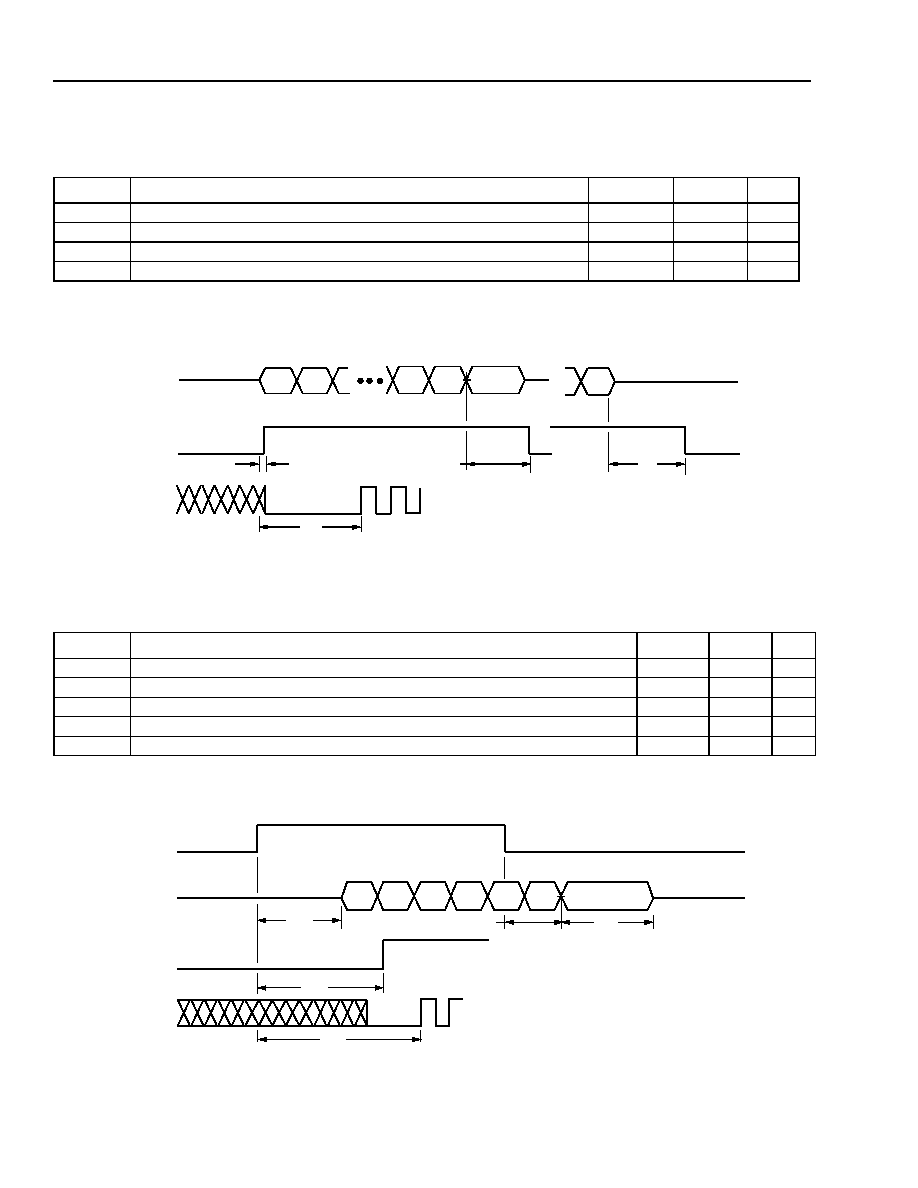
LU3X54FT
Data Sheet
QUAD-FET for 10Base-T/100Base-TX/FX
July 2000
46
Lucent Technologies Inc.
Timing Characteristics (Preliminary)
(continued)
Table 31. Serial 10 Mbits/s Timing for TPIN, CRS, and RX_CLK
5-5293(F).i
Figure 14. Serial 10 Mbits/s Timing for TPIN, CRS, and RX_CLK
Table 32. Serial 10 Mbits/s Timing for TX_EN, TPOUT, CRS, and RX_CLK
5-5293(F).j
Figure 15. Serial 10 Mbits/s Timing for TX_EN, TPOUT, CRS, and RX_CLK
Name
Parameter
Min
Max
Unit
t15
TPIN Activity to CRS Assertion
40
500
ns
t16
TPIN Activity to RX_CLK Valid
800
2300
ns
t17
IDL to CRS Deassertion
200
550
ns
t18
Dead Signal to CRS Deassertion
400
1000
ns
Name
Parameter
Min
Max
Unit
t19
TX_EN Asserted to Transmit Pair Activity
50
400
ns
t20
TX_EN Asserted to CRS Asserted Due to Internal Loopback
5
1900
ns
t21
TX_EN Asserted to RX_CLK Valid Due to Internal Loopback
1000
1700
ns
t22
TX_EN Deasserted to IDL Transmission
50
300
ns
t23
IDL Pulse Width
250
350
ns
TPIN
±
CRS
(RECEIVE--START OF PACKET)
(RECEIVE--END OF PACKET)
(RECEIVE--DEAD SIGNAL)
(NOT IDL)
IDL
t15
t17
t16
t18
RX_CLK
TPOUT
±
CRS
(TRANSMIT--START OF PACKET)
(TRANSMIT--END OF PACKET)
IDL
t19
t22
t20
t21
t23
TX_EN
RX_CLK
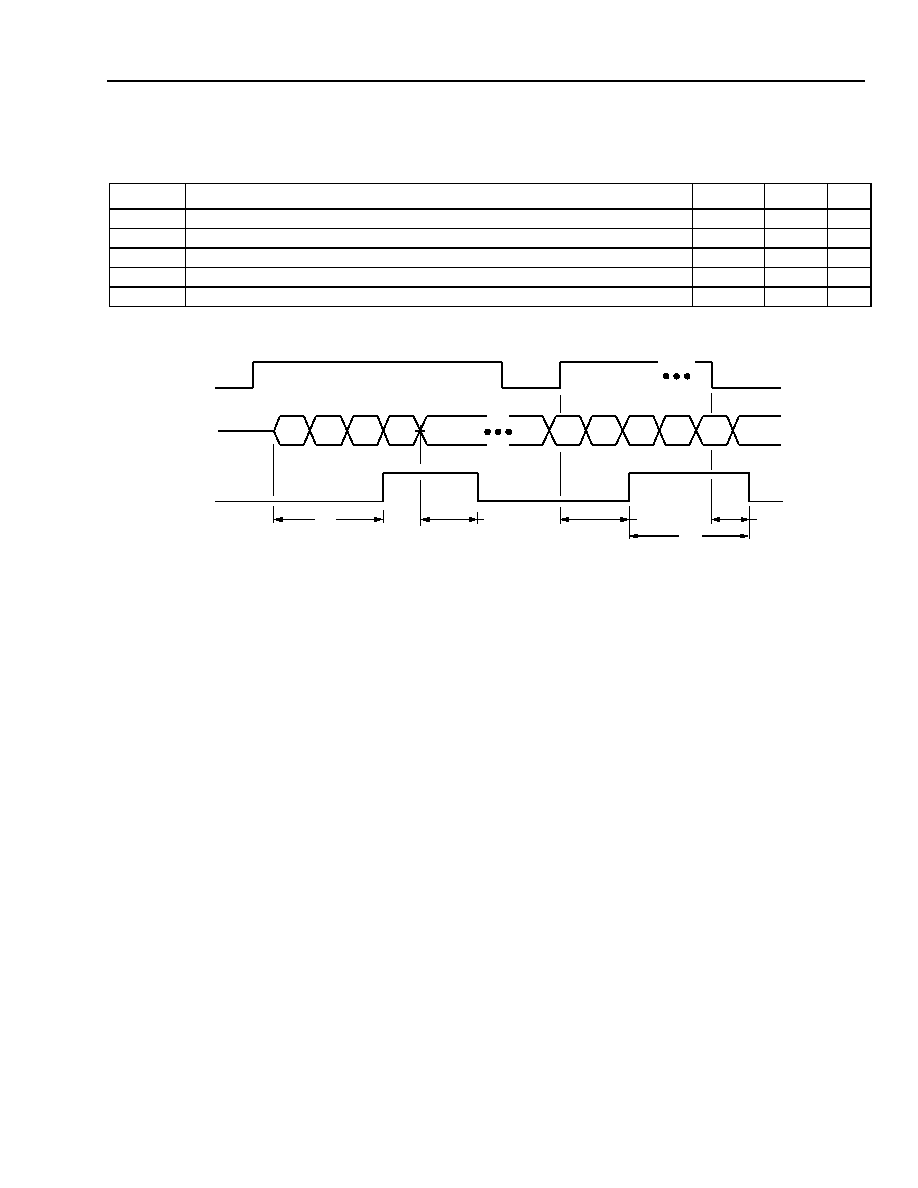
Lucent Technologies Inc.
47
Data Sheet
LU3X54FT
July 2000
QUAD-FET for 10Base-T/100Base-TX/FX
Timing Characteristics (Preliminary)
(continued)
Table 33. Serial 10 Mbits/s Timing for TX_EN, TPIN, and COL
5-5293(F).k
Figure 16. Serial 10 Mbits/s Timing for TX_EN, TPIN, and COL
Name
Parameter
Min
Max
Unit
t24
Time to Assert COL; LU3X54FT Is Transmitting; Receive Activity Starts
40
400
ns
t25
Time to Deassert COL; LU3X54FT Is Transmitting; Receive Activity Ceases
300
900
ns
t26
Time to Assert COL; LU3X54FT Is Receiving; Transmit Activity Starts
5
400
ns
t27
Time to Deassert COL; LU3X54FT Is Receiving; Transmit Activity Ceases
5
900
ns
t28
COL Pulse Width
100
--
ns
TPIN
±
COL
(TRANSMITTING--RECEIVE COLLISION DETECTED)
(RECEIVING--TRANSMIT COLLISON DETECTED)
IDL
t24
t25
t26
t27
t28
TX_EN
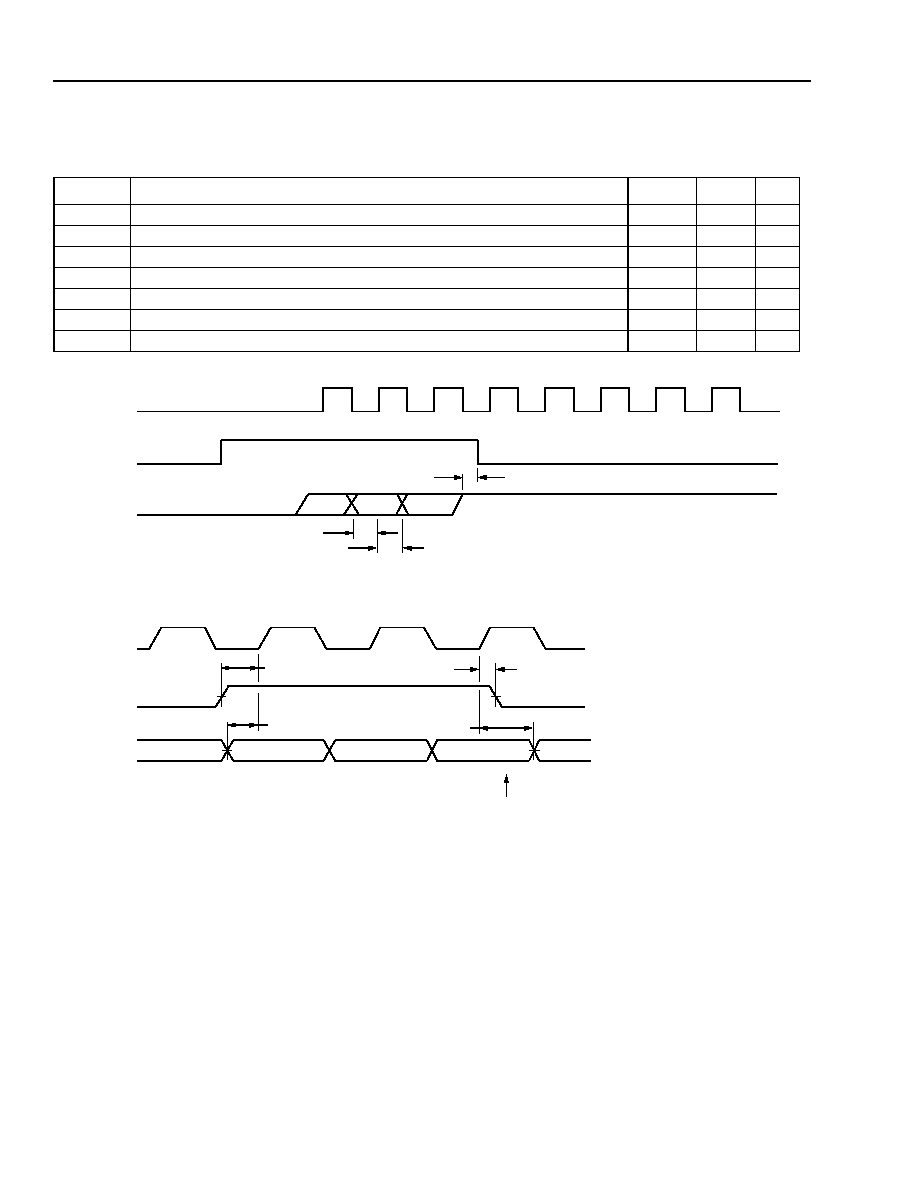
LU3X54FT
Data Sheet
QUAD-FET for 10Base-T/100Base-TX/FX
July 2000
48
Lucent Technologies Inc.
Timing Characteristics (Preliminary)
(continued)
Table 34. Serial 10 Mbits/s Timing for RX_CLK, CRS, RXD, TX_CLK, TX_EN, and TXD (25 pF Load)
5-2736(F).dr1
Figure 17. Serial 10 Mbits/s Timing for RX_CLK, CRS, RXD, TX_CLK, TX_EN, and TXD
Name
Parameter
Min
Max
Unit
t29
RXD Setup Before RX_CLK Rising Edge
30
--
ns
t30
RXD Held Past RX_CLK Edge
30
--
ns
t31
RX_CLK Low to CRS Deassertion (at end of received packet)
40
--
ns
t32
TX_EN Setup Before TX_CLK Rising Edge
30
--
ns
t33
TX_EN Held Past TX_CLK Rising Edge
0
--
ns
t34
TXD Setup Before TX_CLK Rising Edge
30
--
ns
t35
TXD Held Past TX_CLK Rising Edge
0
--
ns
t31
t30
t29
RX_CLK
CRS
RXD
t32
t34
t33
t35
LAST BIT
TX_CLK
TX_EN
TXD
(START OF PACKET)
(END OF PACKET)
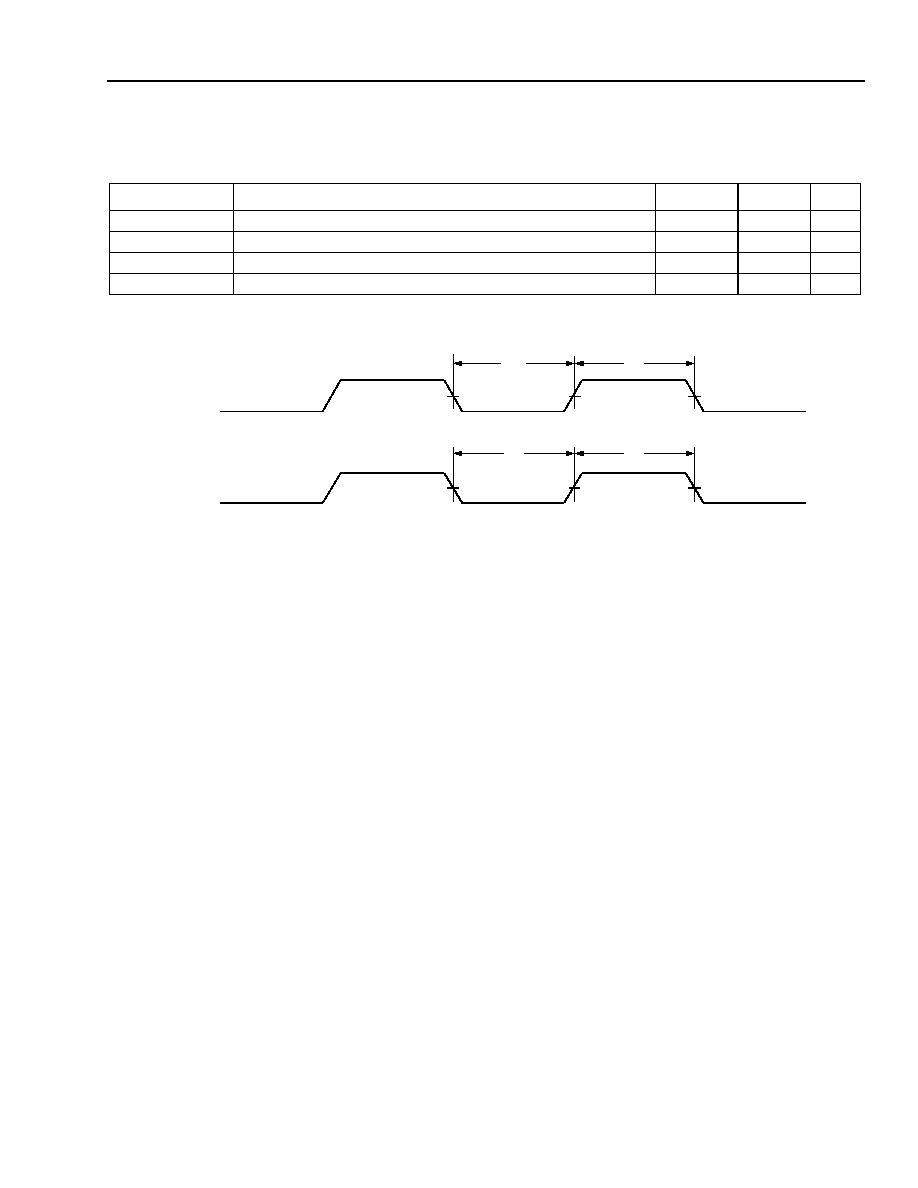
Lucent Technologies Inc.
49
Data Sheet
LU3X54FT
July 2000
QUAD-FET for 10Base-T/100Base-TX/FX
Timing Characteristics (Preliminary)
(continued)
Table 35. Serial 10 Mbits/s Timing for RX_CLK and TX_CLK (25 pF Load)
5-2737(F).dr1
Figure 18. Serial 10 Mbits/s Timing Diagram for RX_CLK and TX_CLK
Name
Parameter
Min
Max
Unit
t36
RX_CLK Low Pulse Width
45
55
ns
t37
RX_CLK High Pulse Width
45
55
ns
t38
TX_CLK Low Pulse Width
45
55
ns
t39
TX_CLK High Pulse Width
45
55
ns
RX_CLK
TX_CLK
t36
t37
t39
t38
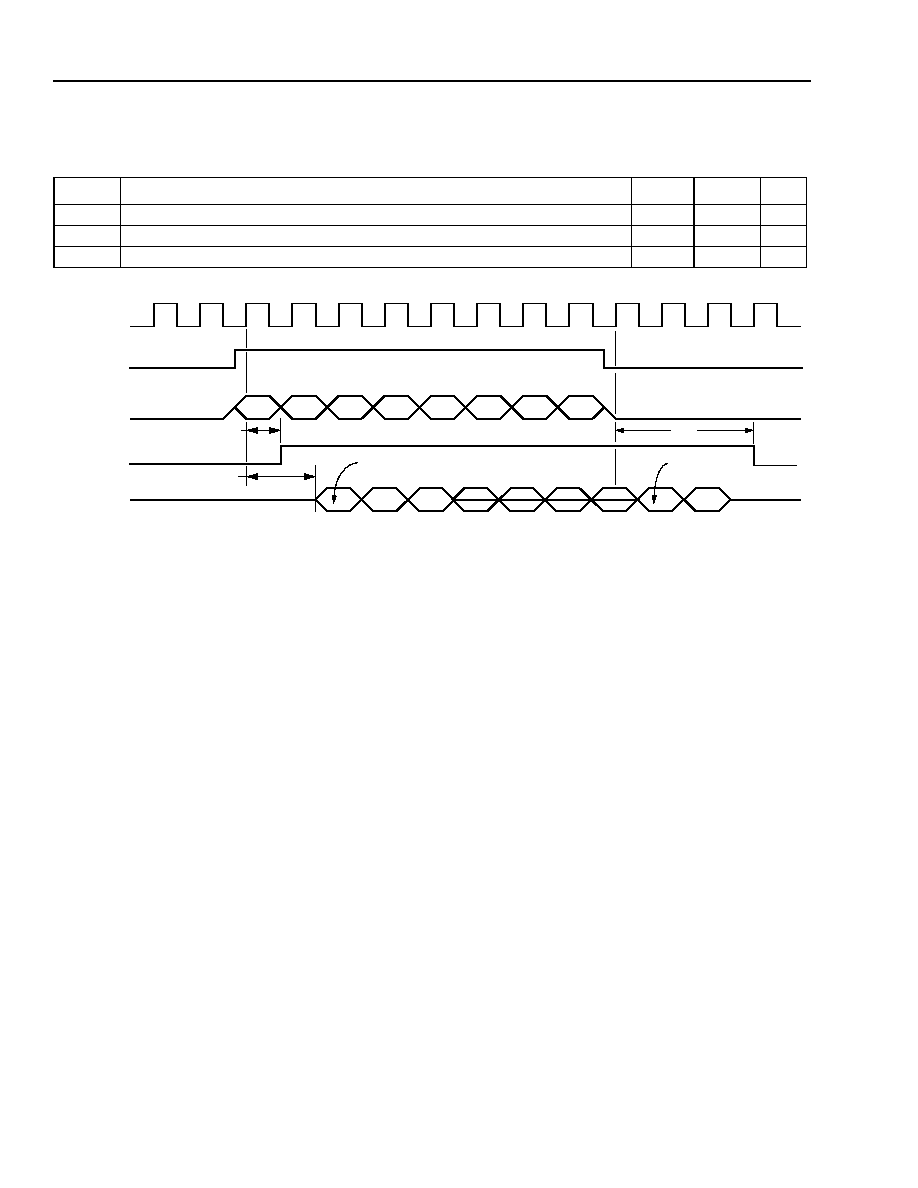
LU3X54FT
Data Sheet
QUAD-FET for 10Base-T/100Base-TX/FX
July 2000
50
Lucent Technologies Inc.
Timing Characteristics (Preliminary)
(continued)
Table 36. 100 Mbits/s MII Transmit Timing
5-3745(F).d
Figure 19. 100 Mbits/s MII Transmit Timing
Name
Parameter
Min
Max
Unit
t40
Rising Edge of TX_CLK Following TX_EN Assertion to CRS Assertion
--
40
ns
t41
Rising Edge of TX_CLK Following TX_EN Assertion to TPOUT
±
--
60
ns
t42
Rising Edge of TX_CLK Following TX_EN Deassertion to CRS Deassertion
--
40
ns
TX_CLK
TX_EN
TXD[3:0]
CRS
TPOUT
±
t40
t41
t42
1st BIT OF J
1st BIT OF T
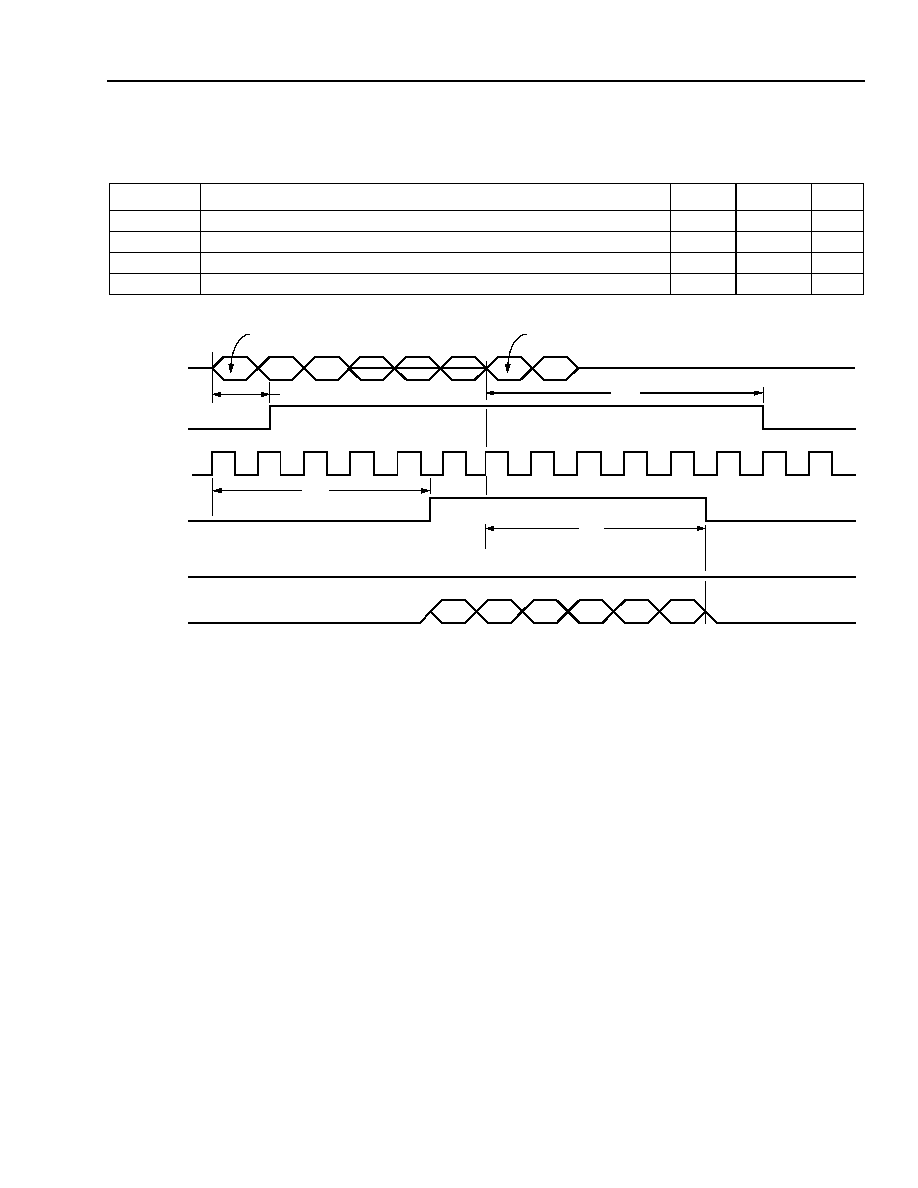
Lucent Technologies Inc.
51
Data Sheet
LU3X54FT
July 2000
QUAD-FET for 10Base-T/100Base-TX/FX
Timing Characteristics (Preliminary)
(continued)
Table 37. 100 Mbits/s MII Receive Timing
5-3747(F).d
Figure 20. 100 Mbits/s MII Receive Timing
Name
Parameter
Min
Max
Unit
t43
TPIN
±
1st Bit of J Receive Activity to CRS Asserted
--
170
ns
t44
TPIN
±
Receive Activity to Receive Data Valid
--
210
ns
t45
TPIN
±
Receive Activity Cease (1st bit of T) to CRS Deasserted
--
210
ns
t46
TPIN
±
Receive Activity Cease (1st bit of T) to Receive Data Not Valid
--
210
ns
TPIN
±
t43
t45
t46
CRS
RX_CLK
RX_DV
RX_ER
RXD[3:0]
t44
1st BIT OF J
1st BIT OF T
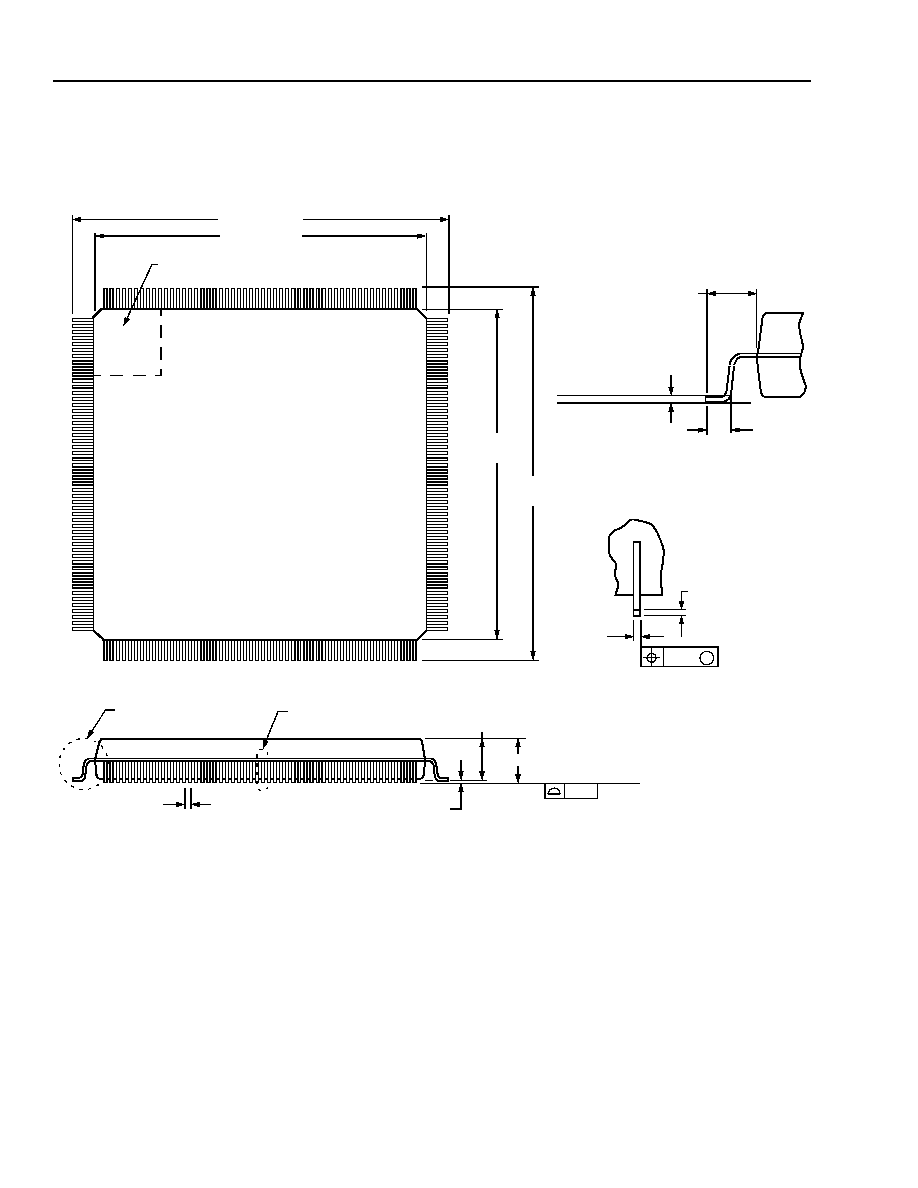
LU3X54FT
Data Sheet
QUAD-FET for 10Base-T/100Base-TX/FX
July 2000
52
Lucent Technologies Inc.
Outline Diagram
208-Pin SQFP
Dimensions are in millimeters.
5-2196(F).r13
156
105
30.60 ± 0.20
157
208
1
52
53
104
28.00 ± 0.20
28.00
± 0.20
30.60
± 0.20
PIN #1 IDENTIFIER ZONE
4.10 MAX
0.08
3.40 ± 0.20
SEATING PLANE
0.25 MIN
0.50 TYP
DETAIL B
DETAIL A
0.50/0.75
GAGE PLANE
SEATING PLANE
1.30 REF
0.25
DETAIL A
DETAIL B
0.17/0.27
0.10
M
0.090/0.200

Lucent Technologies Inc.
53
Data Sheet
LU3X54FT
July 2000
QUAD-FET for 10Base-T/100Base-TX/FX
Ordering Information
*Refer to package and thermal characteristics
Device Code
Comcode
Package
Temperature
LU3X54FT-HS208
108193384
208-Pin SQFPH (Heat Spreader)
0
∞
C to 70
∞
C
LU3X54FT-S208
108297334
208-Pin SQFP
0
∞
C to 70
∞
C*

Lucent Technologies Inc. reserves the right to make changes to the product(s) or information contained herein without notice. No liability is assumed as a result of their use or application. No
rights under any patent accompany the sale of any such product(s) or information.
Copyright © 2000 Lucent Technologies Inc.
All Rights Reserved
July 2000
DS99-246LAN (Replaces DS98-349LAN)
For additional information, contact your Microelectronics Group Account Manager or the following:
INTERNET:
http://www.lucent.com/micro
E-MAIL:
docmaster@micro.lucent.com
N. AMERICA:
Microelectronics Group, Lucent Technologies Inc., 555 Union Boulevard, Room 30L-15P-BA, Allentown, PA 18109-3286
1-800-372-2447, FAX 610-712-4106 (In CANADA: 1-800-553-2448, FAX 610-712-4106)
ASIA PACIFIC: Microelectronics Group, Lucent Technologies Singapore Pte. Ltd., 77 Science Park Drive, #03-18 Cintech III, Singapore 118256
Tel. (65) 778 8833, FAX (65) 777 7495
CHINA:
Microelectronics Group, Lucent Technologies (China) Co., Ltd., A-F2, 23/F, Zao Fong Universe Building, 1800 Zhong Shan Xi Road,
Shanghai 200233 P. R. China Tel. (86) 21 6440 0468, ext. 325, FAX (86) 21 6440 0652
JAPAN:
Microelectronics Group, Lucent Technologies Japan Ltd., 7-18, Higashi-Gotanda 2-chome, Shinagawa-ku, Tokyo 141, Japan
Tel. (81) 3 5421 1600, FAX (81) 3 5421 1700
EUROPE:
Data Requests: MICROELECTRONICS GROUP DATALINE: Tel. (44) 1189 324 299, FAX (44) 1189 328 148
Technical Inquiries: GERMANY: (49) 89 95086 0 (Munich), UNITED KINGDOM: (44) 1344 865 900 (Bracknell),
FRANCE: (33) 1 48 83 68 00 (Paris), SWEDEN: (46) 8 600 7070 (Stockholm), FINLAND: (358) 9 4354 2800 (Helsinki),
ITALY: (39) 2 6608131 (Milan), SPAIN: (34) 1 807 1441 (Madrid)





















































